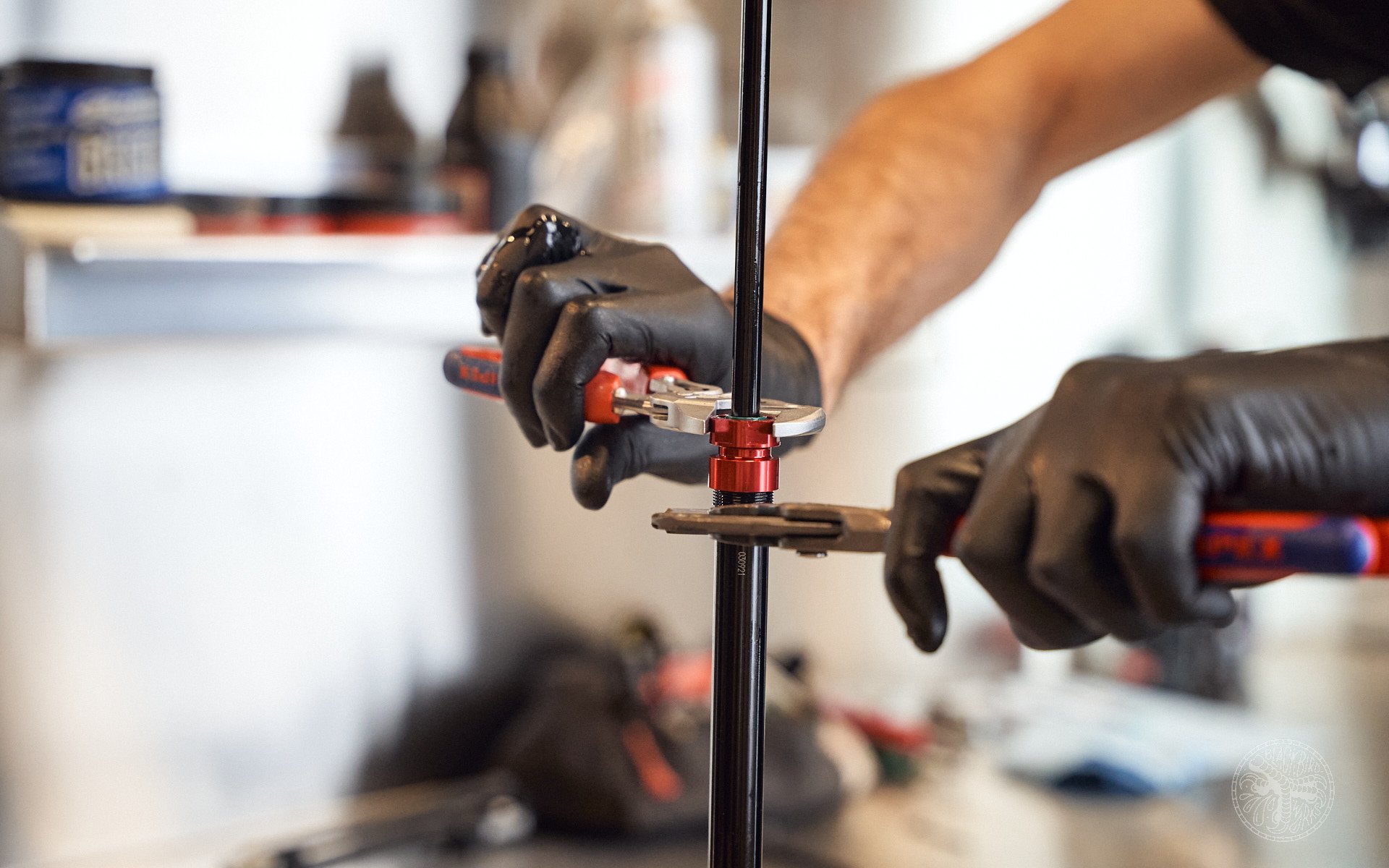
TEARDOWN
2023 RockShox Forks
This is a big day for RockShox who are launching all new forks (Zeb, Lyrik, and Pike) and Super Deluxe air and coil shocks for the 2023 model year. We got our hands on some of the new stuff in advance and have got a series of articles for you. Besides this tear down of the new forks, there is a tear down of the new shocks as well as Cam and Pete's riding impressions of some of these new RockShox releases.
Specificity
All across the bikernet today you're seeing first impression reviews from test-writers lucky enough to have had their hands on RockShox's top-end model year 2023 (MY23) forks and shocks for at least a few weeks now. You'll be reading things like how the new Charger 3 damper has "drastically reduced the amount of harshness that makes it to the rider’s hands" and how switching from a bladder to an IFP design allowed SRAM "to focus on tunability and decouple High- and Low-Speed Compression, avoiding cross-talk between the two settings." There are pressure relief valves (PRV) on the lowers, ButterCups which help to damp trail noise, and the new DebonAir+ air spring. It all adds up to a lot of new stuff going on in RockShox's flagship forks.
If you're currently looking at your current Lyrik Ultimate, rubbing your chin, and thinking 'A, B, C, D, E, F-me, I thought this thing was rad,' I'm sorry to say that I can't tell you how many percent better the new forks are in which percentage of what moments. I will quote some RockShox numbers here and tell you how they came about them. I haven't ridden the new forks or shocks but I have seen inside them and from a manufacturing perspective I think it's fair to say these premium forks & shocks look premium. On its face, this is a teardown article that will look at RockShox's new MY23 forks. I've also put together a similar piece about the new shocks.
But I also can't just dump the photos into an article without talking about the bigger theme that's going on here. Specificity. What you're seeing here is not just an evolution that has been occurring since RockShox dropped the first 35mm chassis MY14 Pike. With the exception of the ZEB, which carries forward from MY21, these are all new chassis wrapped in a new design philosophy. And, the answer to the question that may have come to the mind for current RockShox owner is 'No.'
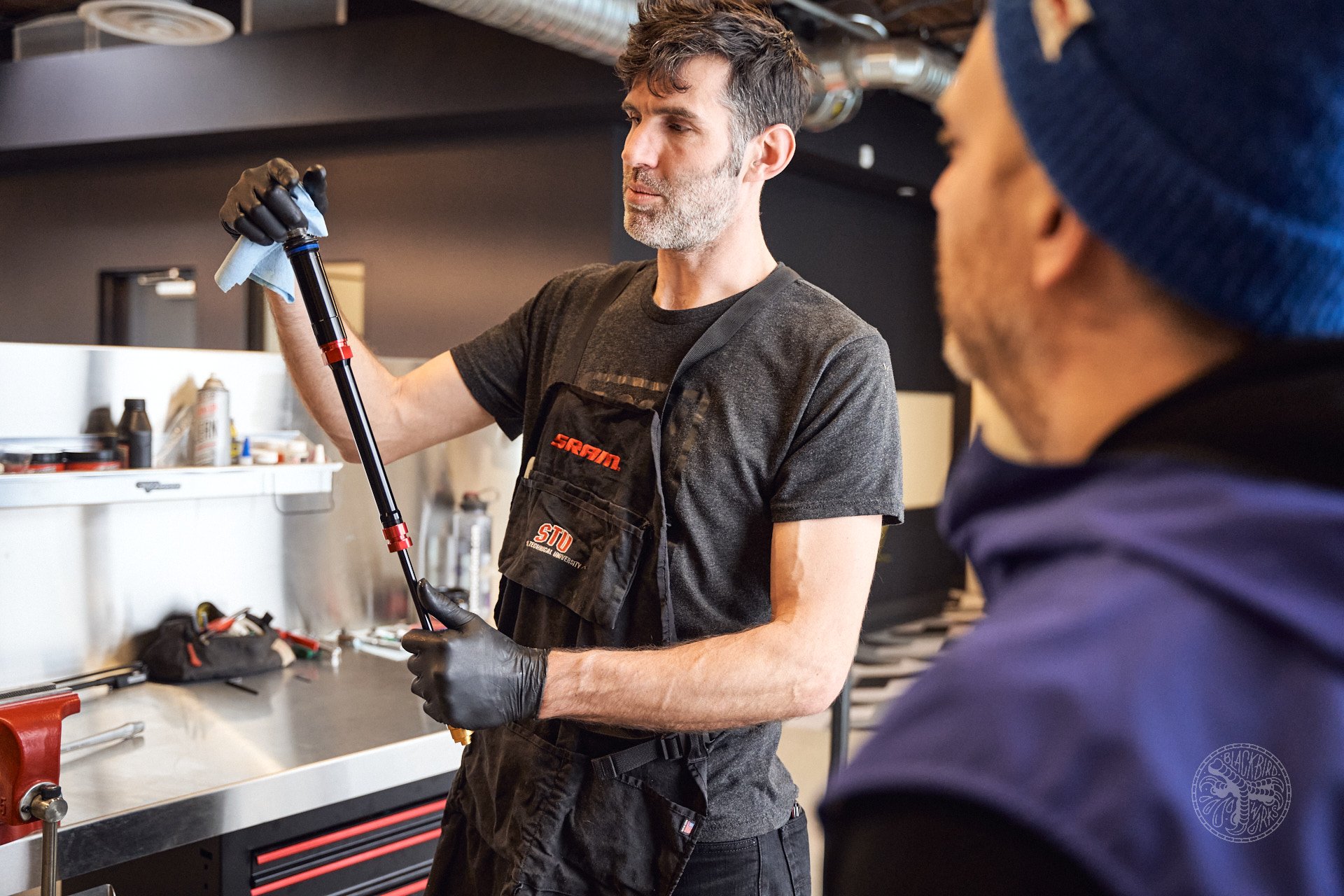
Chris from SRAM talking Deniz and I through the MY23 RockShox Pike Ultimate fork and Super Deluxe shocks.
With one exception, you cannot put the new Charger 3 IFP damper into your existing chassis. No, you cannot put the new DebonAir+ air system into your existing chassis. No, you cannot put ButterCups into the lowers of your existing forks chassis. That exception is that your MY21+ ZEB can accept all these upgrades. Pricing will be available in the future.
The lack of backwards compatibility isn't so much the story here as why that choice was made. RockShox learned that in order to make a big step forward with performance, they needed to build their forks within a narrower, more optimized window. By building forks around limited travel lengths they could reduce friction, increase stiffness through improved bushing overlap, improve air system performance, and reduce chassis weight to make up for system additions like the ButterCups. For tinkerers used to playing swap the air shaft, the optimized air systems may be the more noteworthy change I discuss today.
MY23 RockShox fork travel looks like this:
- Pike: 120mm, 130mm, 140mm
- Lyrik: 140mm, 150mm, 160mm
- ZEB: 160mm, 170mm, 180mm, 190mm
Chris Mandell from SRAM took us through a teardown of the MY23 Pike Ultimate but it acts a stand-in for the other MY23 Ultimate forks (Lyrik and ZEB). As with past RockShox forks, if you are buying a complete bike with a lower than Ultimate spec, right down to the MY23 base forks, you can purchase most of the upgrades to achieve 'Ultimate' level performance from your chassis. The one exception is that the Ultimate forks feature notably longer lower bushings - for friction reduction - and making that change on a less-premium fork requires replacing the lowers.
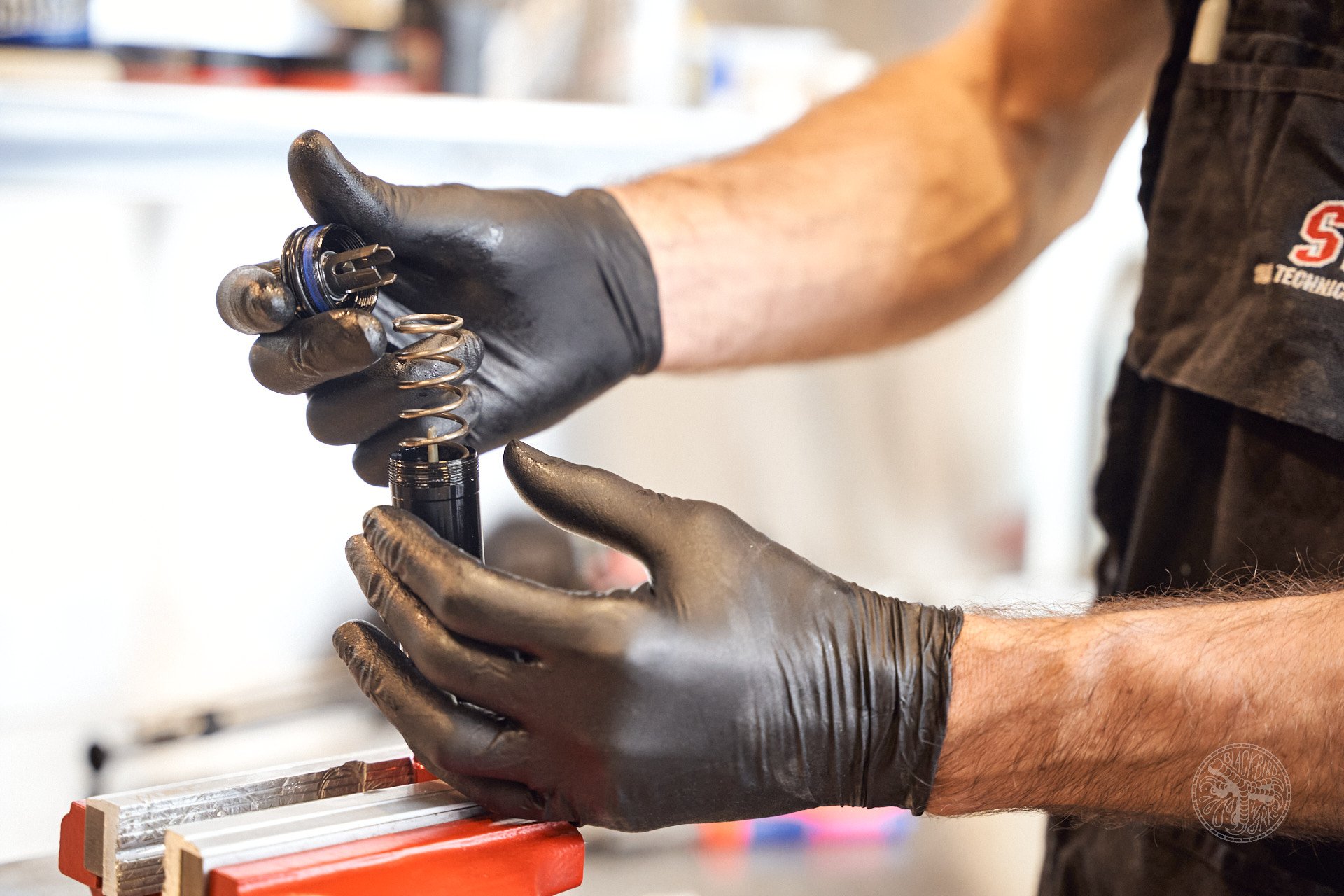
The new Charger 3 damper uses a spring-backed IFP. The design goal with the damper is "engineering complexity for end user simplicity."
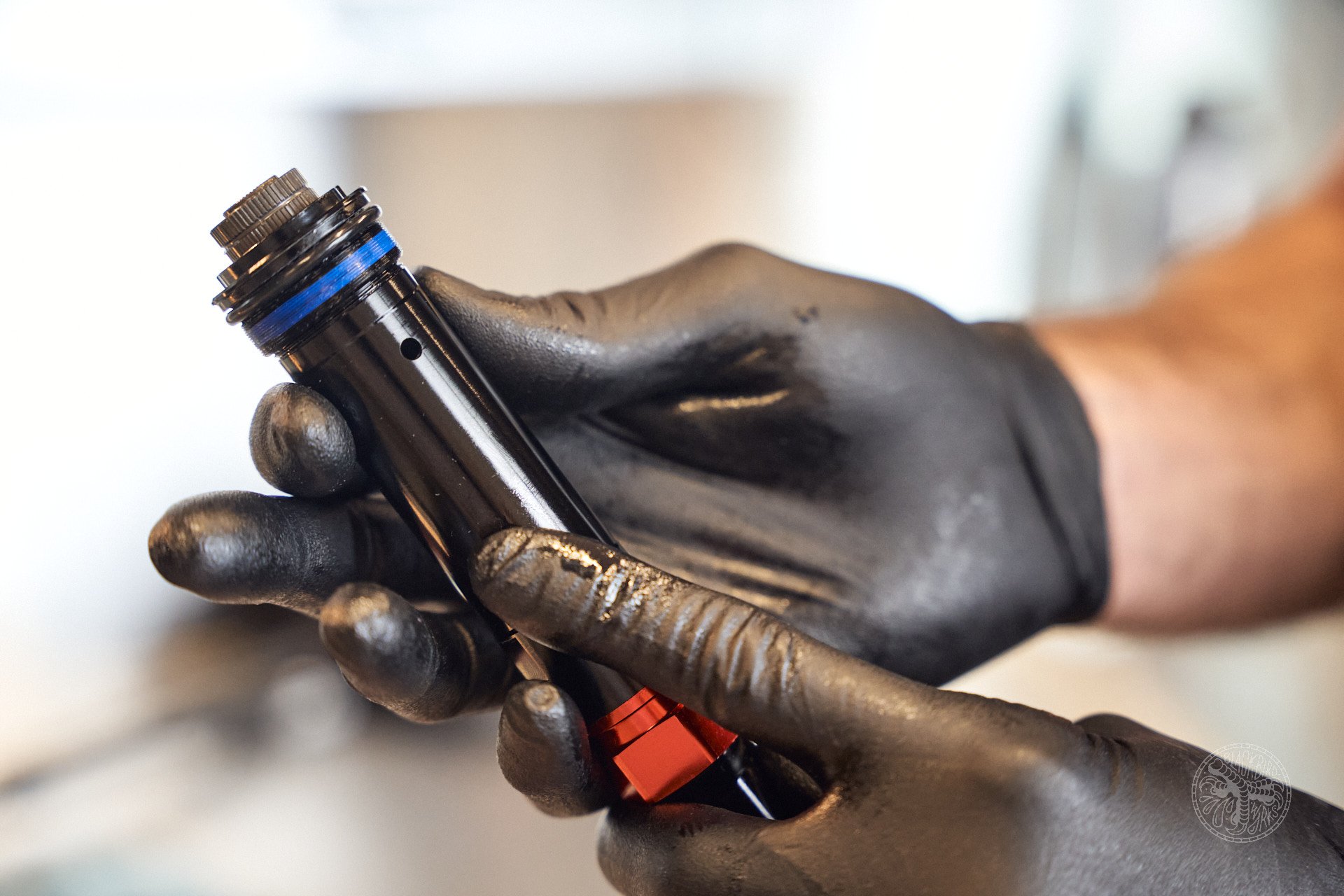
If the new Charger 3 damper ingests oil from the bath lube any excess can be purged out the top. No proprietary tools are needed to service or bleed the damper.
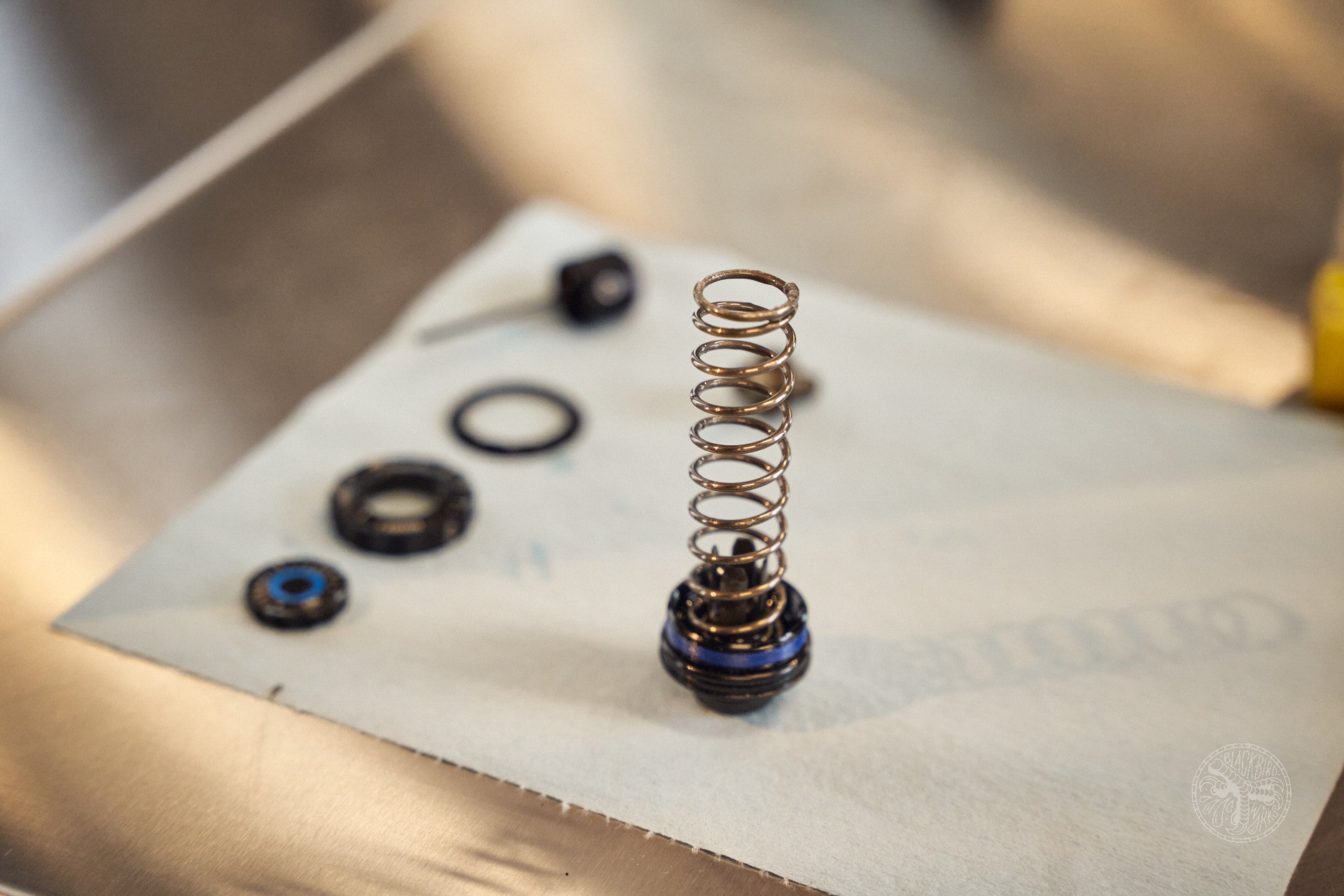
Another look at the coil spring that backs up the internal floating piston (IFP). Despite the dampers being heavier the overall weights of Pike & Lyrik have dropped.
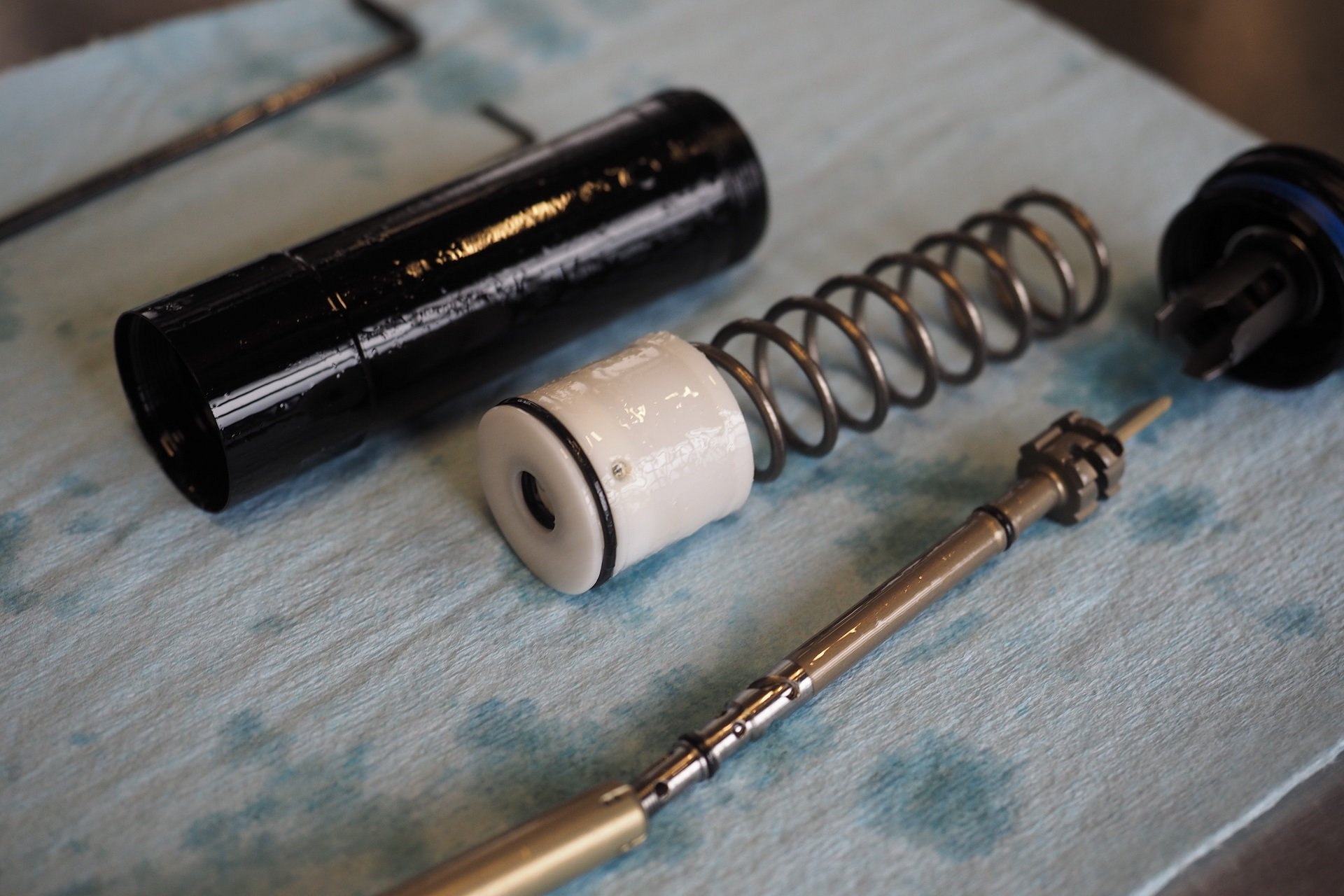
The IFP depth does need to be set, but there's a line inside showing where it goes. No special tools required. Photo: Andrew Major
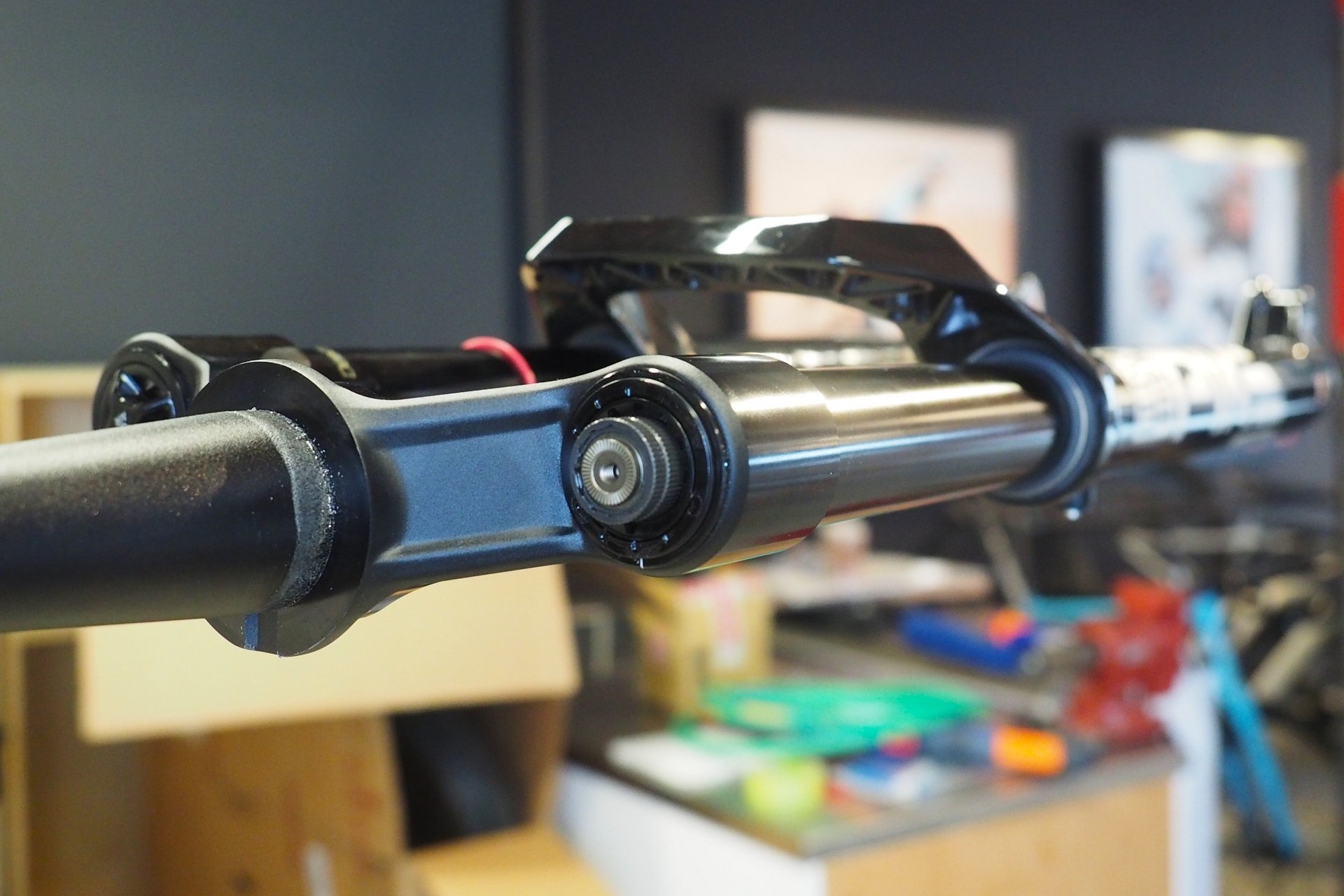
The adjusters go here. New chassis, new air system, new damper, new features. It's all new! Photo: Andrew Major
Charger 3
We're in an interesting time with suspension forks, and bikes in general, where there seems to be no limit to the price some firms can command for their premium products. There are multiple options for single crown forks over 2K CAD now which is a few hundred dollar premium over the top end units from more mainstream players like Fox & RockShox. Is it possible that the RockShox Ultimate line of forks are really the 'ultimate' option when they sell for less money?
Looking at some of the neat machined steel and aluminum parts inside the Charger 3 damper, I can't help but draw some correlations to the current electric vehicle market. Big players have economies of scale that smaller companies can't match and at some point you're getting better engineering, superior manufacturing, and better longevity. In short, a better product for less money. They can't offer the level of custom tuning that some small-scale suspension outfits deliver, but it will be interesting to read takes from folks who have ridden products from EXT, Öhlins, Formula, Fox and other outfits that are offering damper-forward suspension tech. Likewise, I look forward to comparisons between Charger 3 and folks running the very well-received PUSH HC97 upgrade for Charger 2/2.1 bladder damper systems.
Since Charger 3 is not backwards compatible, there are interesting economic arguments about seeking the best RockShox performance out of a new fork, or purchasing hop-ups for an existing platform. For example, how does a new MY23 Lyrik Ultimate with Charger 3, ButterCups, and DebonAir+ compare to a MY22 Lyrik Ultimate with an HC97 damper upgrade and a Vorsprung Secus air spring kit?
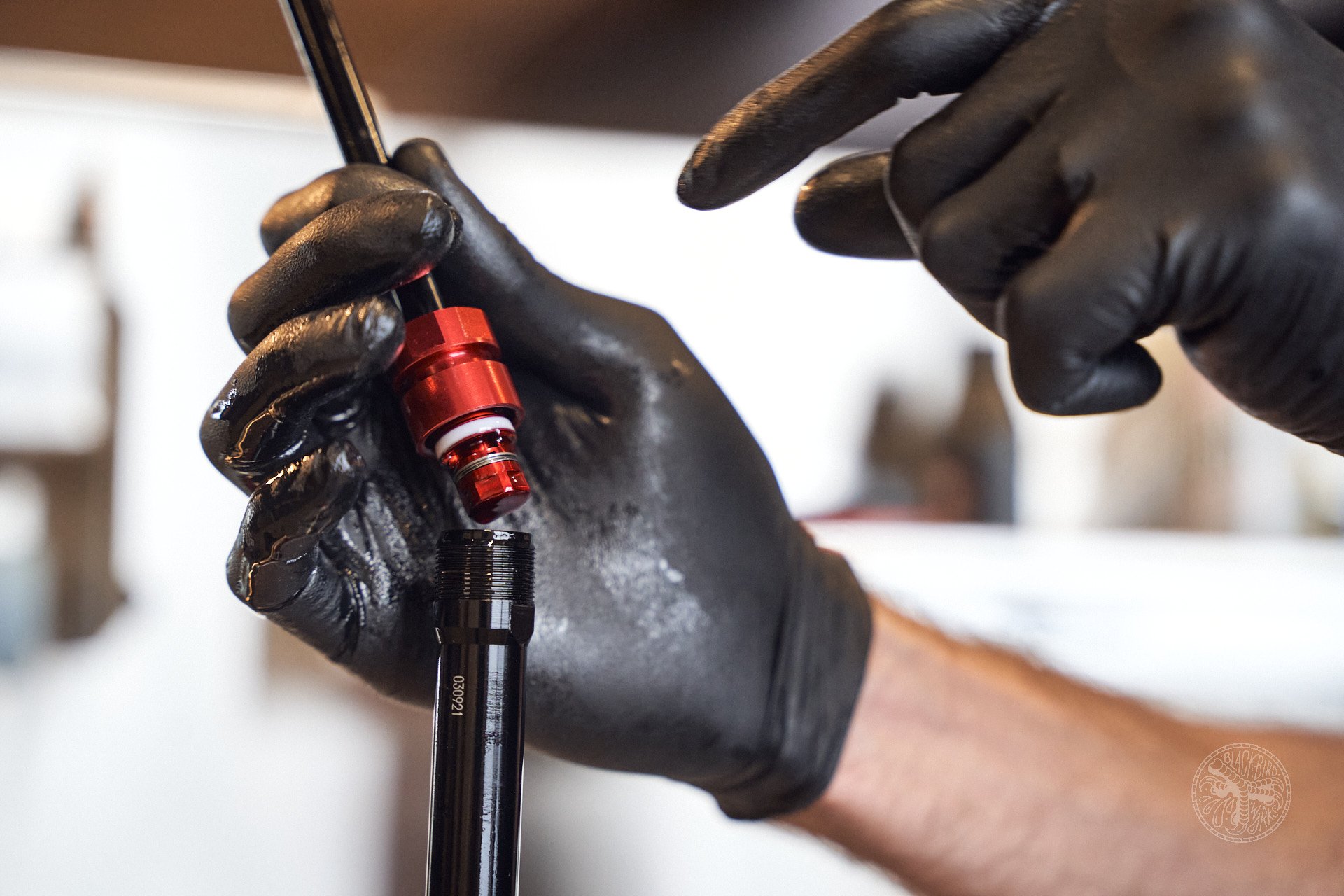
Rebound at the rebound. Compression at the compression. The high-flow goal is no cross-talk between circuits.
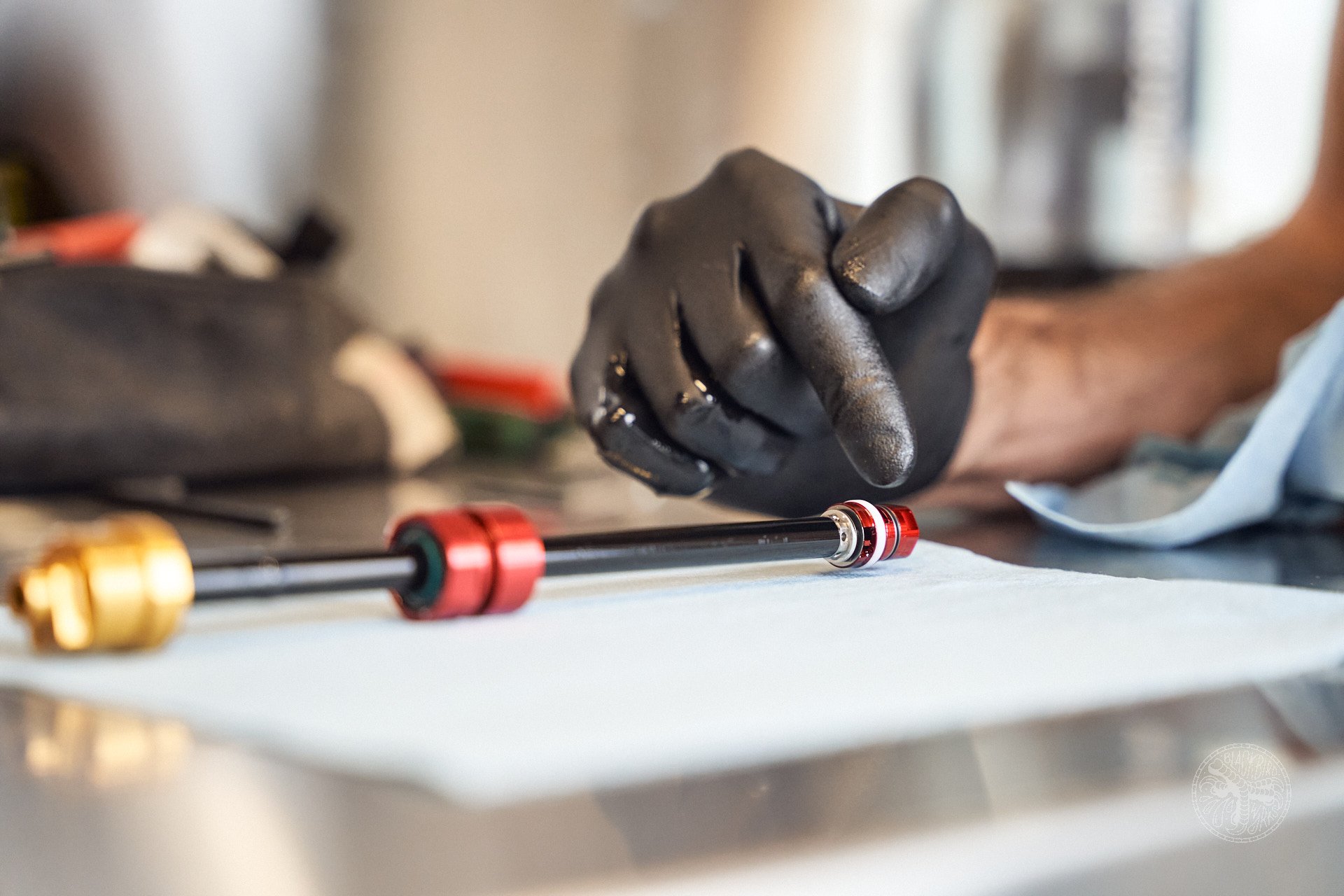
SILENCE! ButterCups quiet trail noise and rebound shim control quiets the damper.
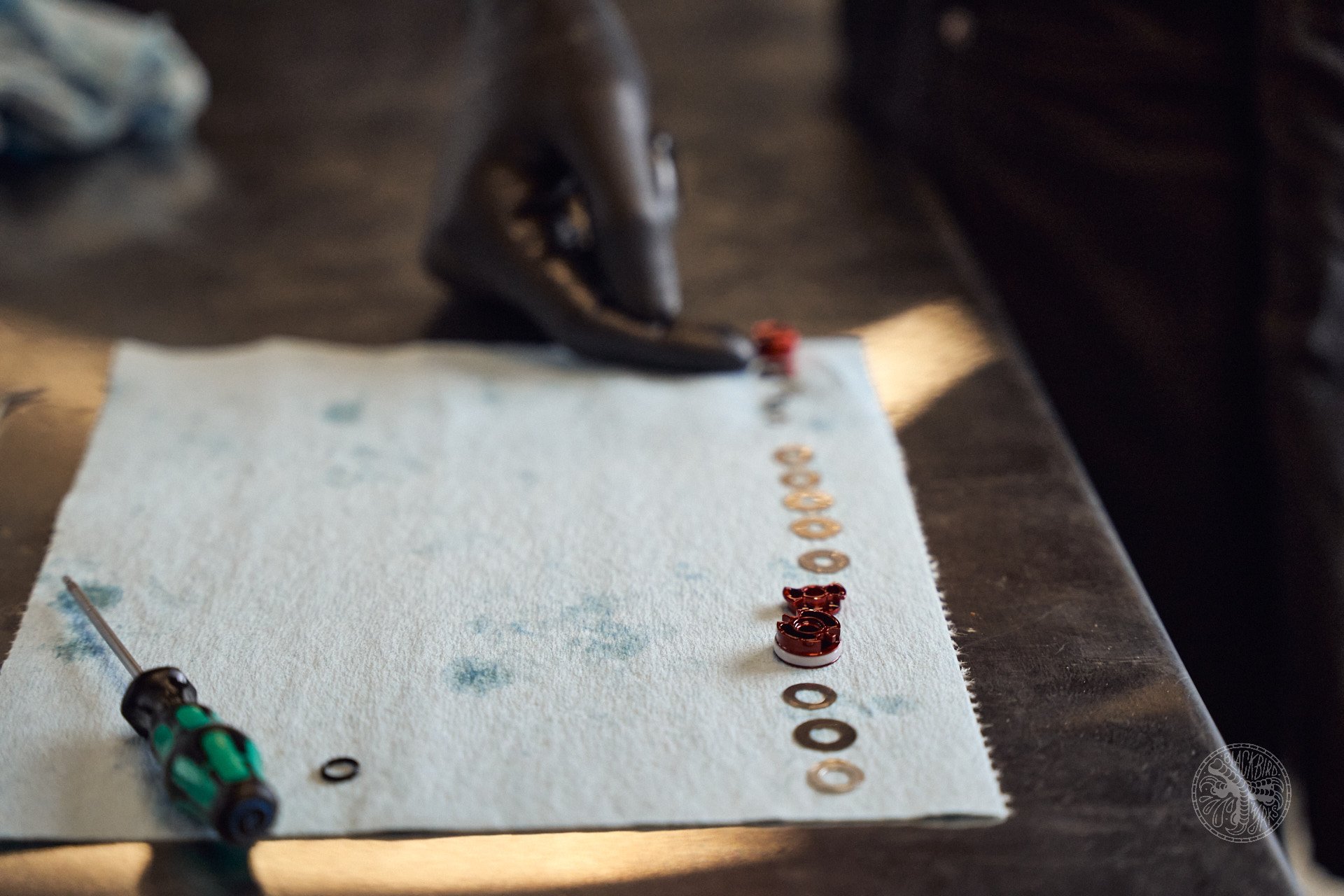
Shims, on shim, on shims. This is the rebound stack.
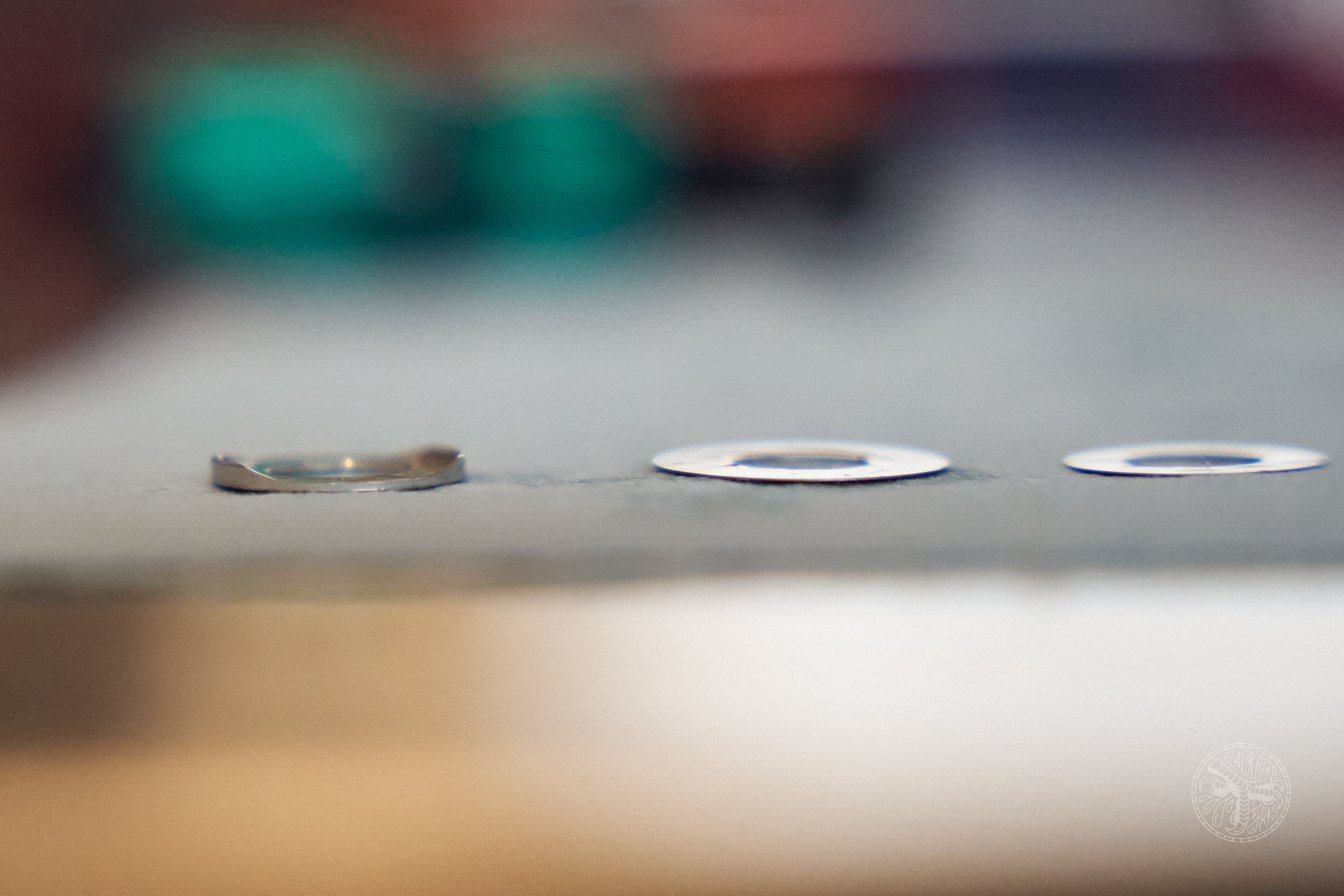
I’m convinced this winged washer was designed by a single-speeder who rides a rigid fork anytime their bosses at SRAM aren’t looking.
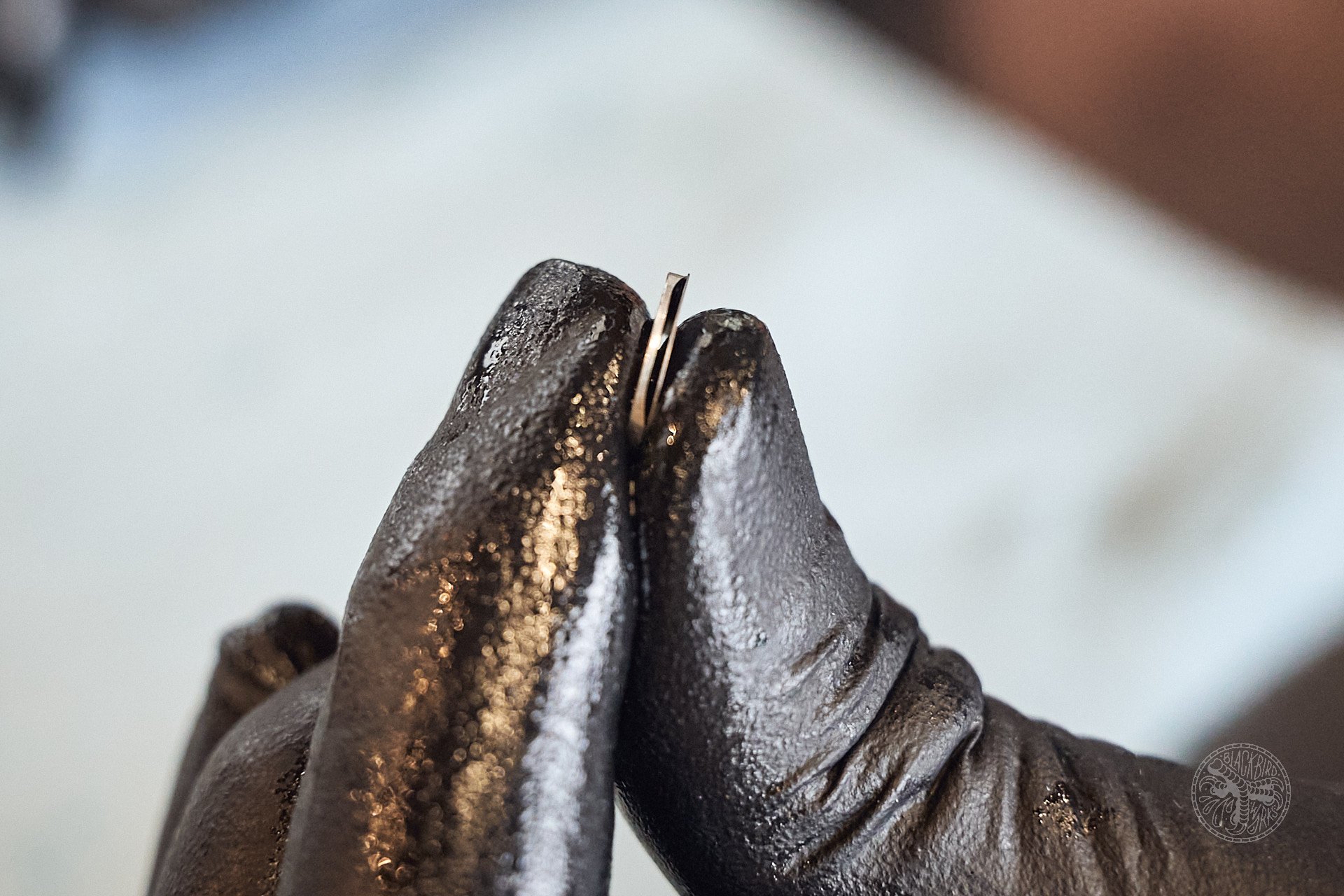
The winged washer acts as spring to hold the check shim against the piston. The shim flexes across the lips to allow oil through.
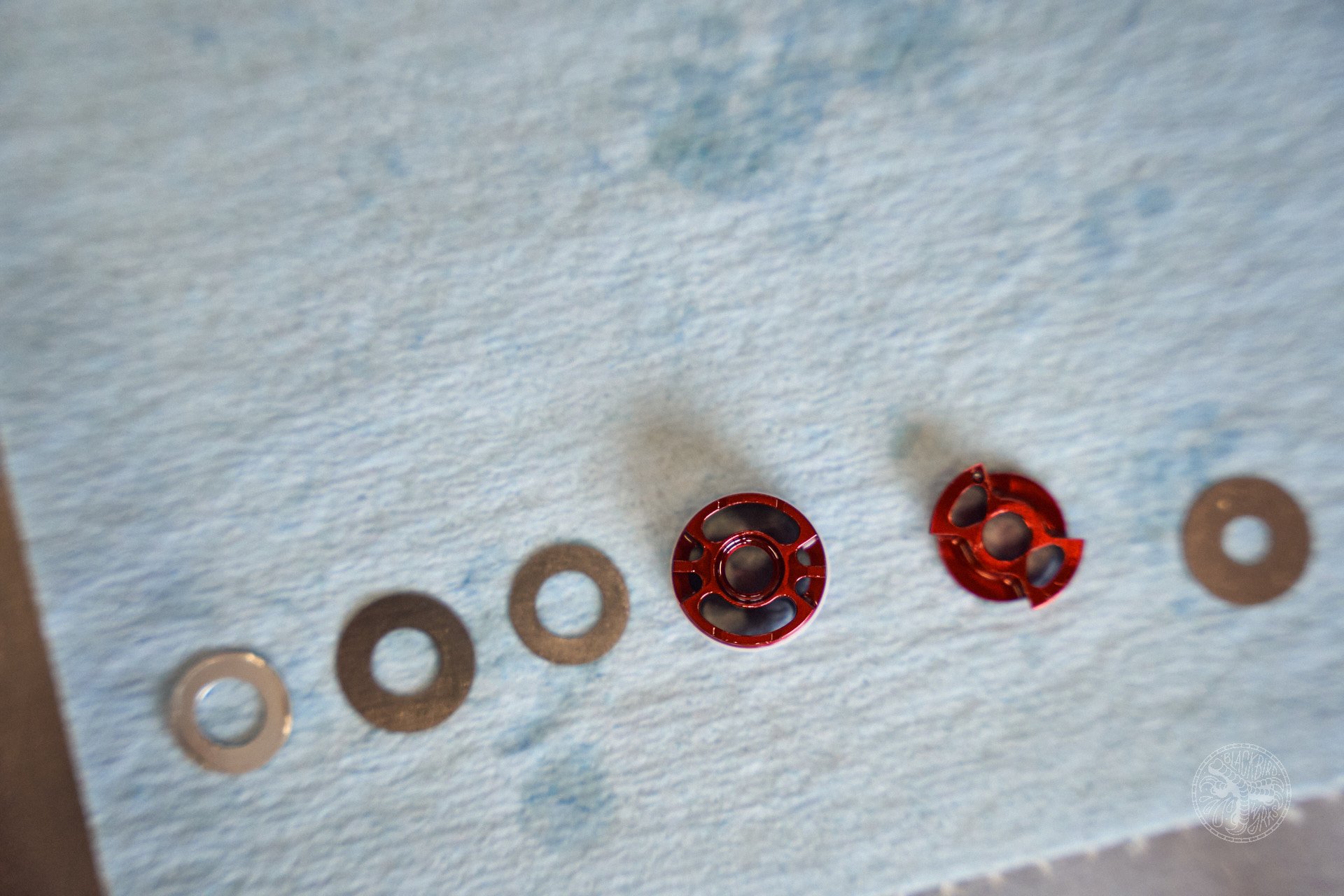
The Rebound check pistons are designed to flow tons of oil so they don't create any compression damping.
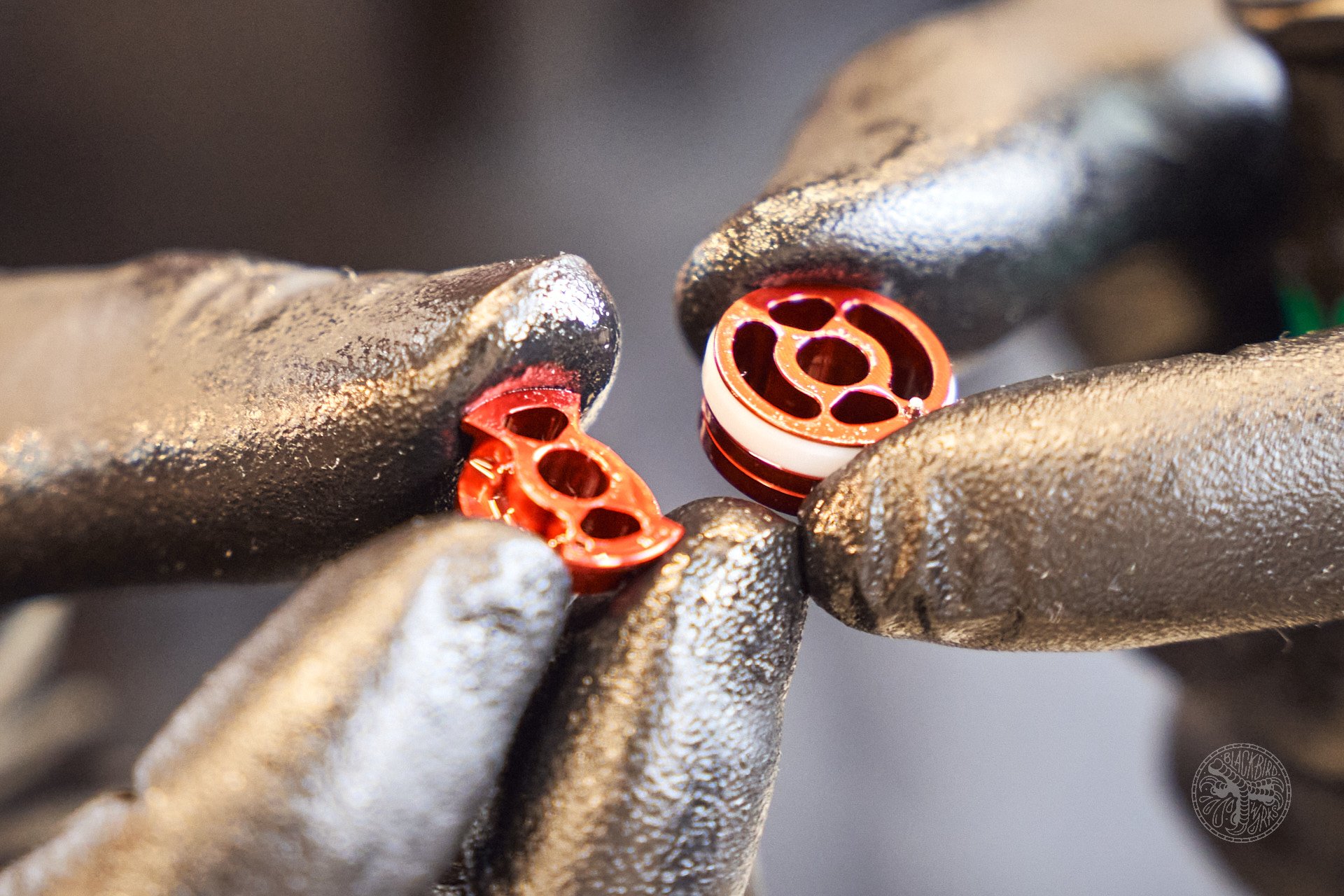
"Hot Dog!" I believe this is what SRAM calls this part, that or I was channeling hunger-related tummy grumbles. Either way the machining maximizes oil flow when the shims open.
The big news with Charger 3 is of course everything. Years after deciding that a bladder damper was the best fit, the new system is using a coil spring-backed internal floating piston (IFP). The switch comes down to two goals. RockShox wanted to reduce harshness in every way possible, and they wanted to remove any cross-talk between the rebound, low-speed compression (LSC), and high-speed compression (HSC) circuits. The damper is also very quiet thanks to the IFP spring and the focus paid to the rebound shim setup where they use a washer with lips as a spring to hold the check shim to the piston.
One way harshness is reduced is by relieving the pressure the SKF seals put on the shaft seal head. Unlike a bladder system where these seals need to keep lower bath oil from migrating into the damper, the Charger 3, like other IFP dampers, is able to recirculate oil that bypasses. Another is oil flow. Specifically, the rebound piston flows a high volume of oil to avoid creating any compression damping itself.
The efforts to eliminate damper cross-talk are interesting to me. Is it really a big deal if you have to dial back HSC a bit when you increase LSC, or vice-versa, and likewise that a preference for rebound setting could also affect how these settings feel? Did folks really have a struggle dialing in their Charger 2.1 damper setup? The new Ultimate forks are an answer to the question of whether riders, and the market, are becoming more sophisticated and RockShox clearly thinks it is. When you're setting up a Charger 3 fork, you can be confident the three damper settings do not impact each other (though it may be possible to see minute differences on a dyno). RockShox has also put a great deal of effort into making it so that each click of an adjuster has the same effect as the others, which I know is a common complaint with some other damper systems. SRAM says you will perceive notable, consistent changes as you click through the various settings.
Charger 3 Damper Settings:
- LSC 15 Clicks
- HSC 5 Clicks
- Rebound 18 Clicks
Forks coming stock with Charger 3:
- Pike Ultimate (w/ ButterCups) | Pike Select+ (No ButterCups)
- Lyrik Ultimate (w/ ButterCups) | Lyrik Select+ (No ButterCups)
- ZEB Ultimate (w/ ButterCups) | ZEB Select+ (No ButterCups)
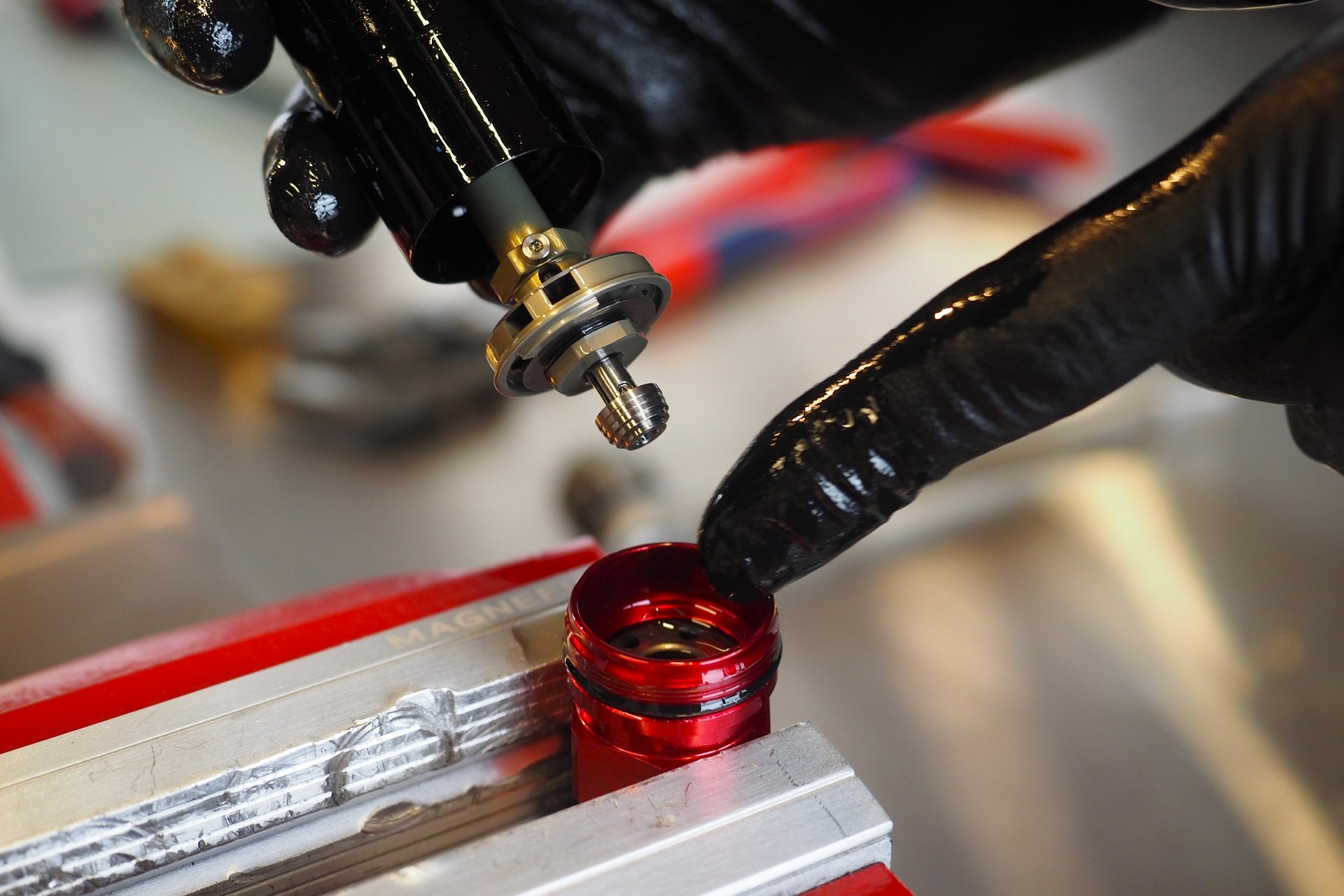
Note how the 5 steps on the stainless steel HSC stud are different. This is engineered so each click changes compression by the exact amount of force. Photo: Andrew Major
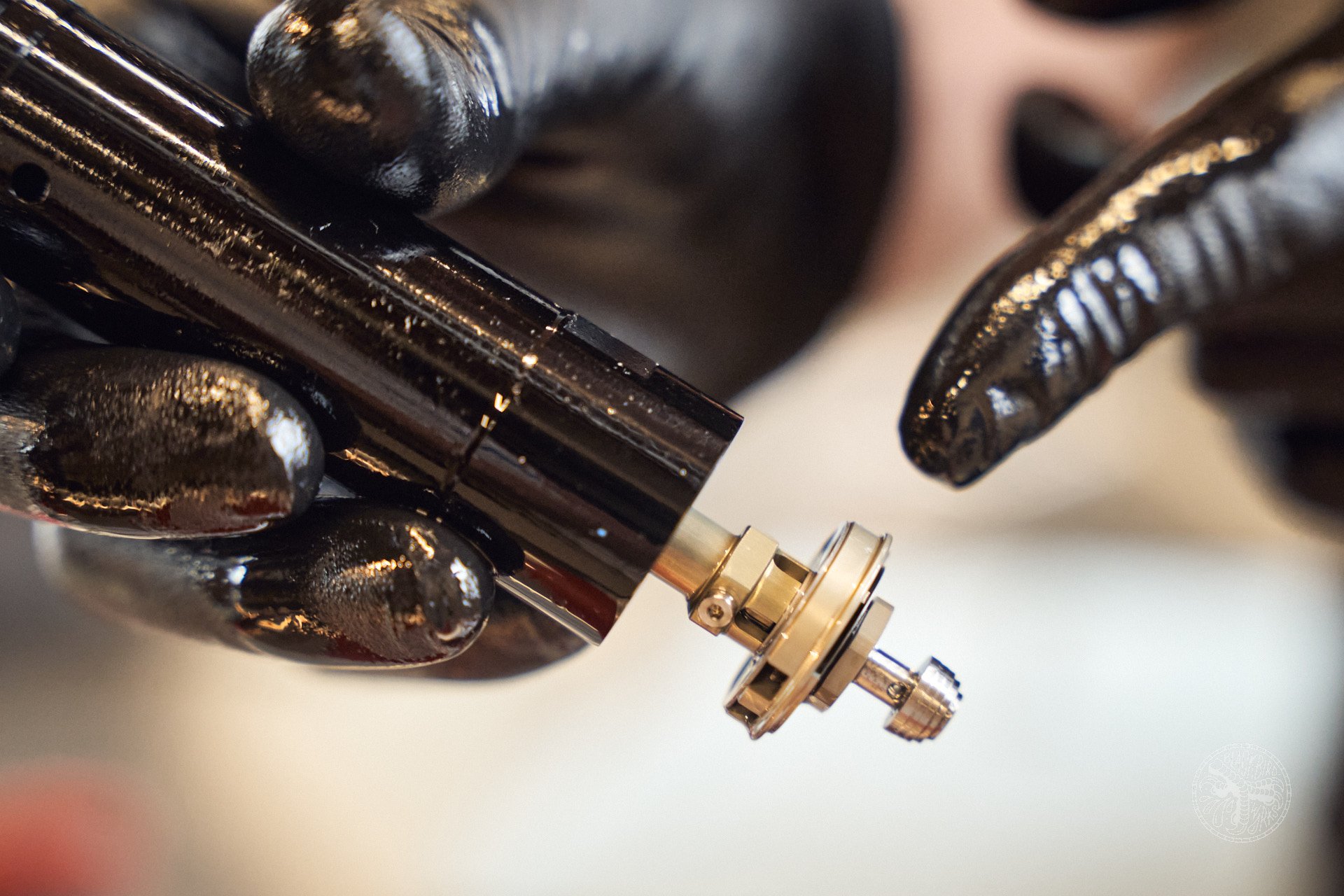
High speed flow happens first. A small amount of oil flows past the HSC circuit and through to the LSC circuit.
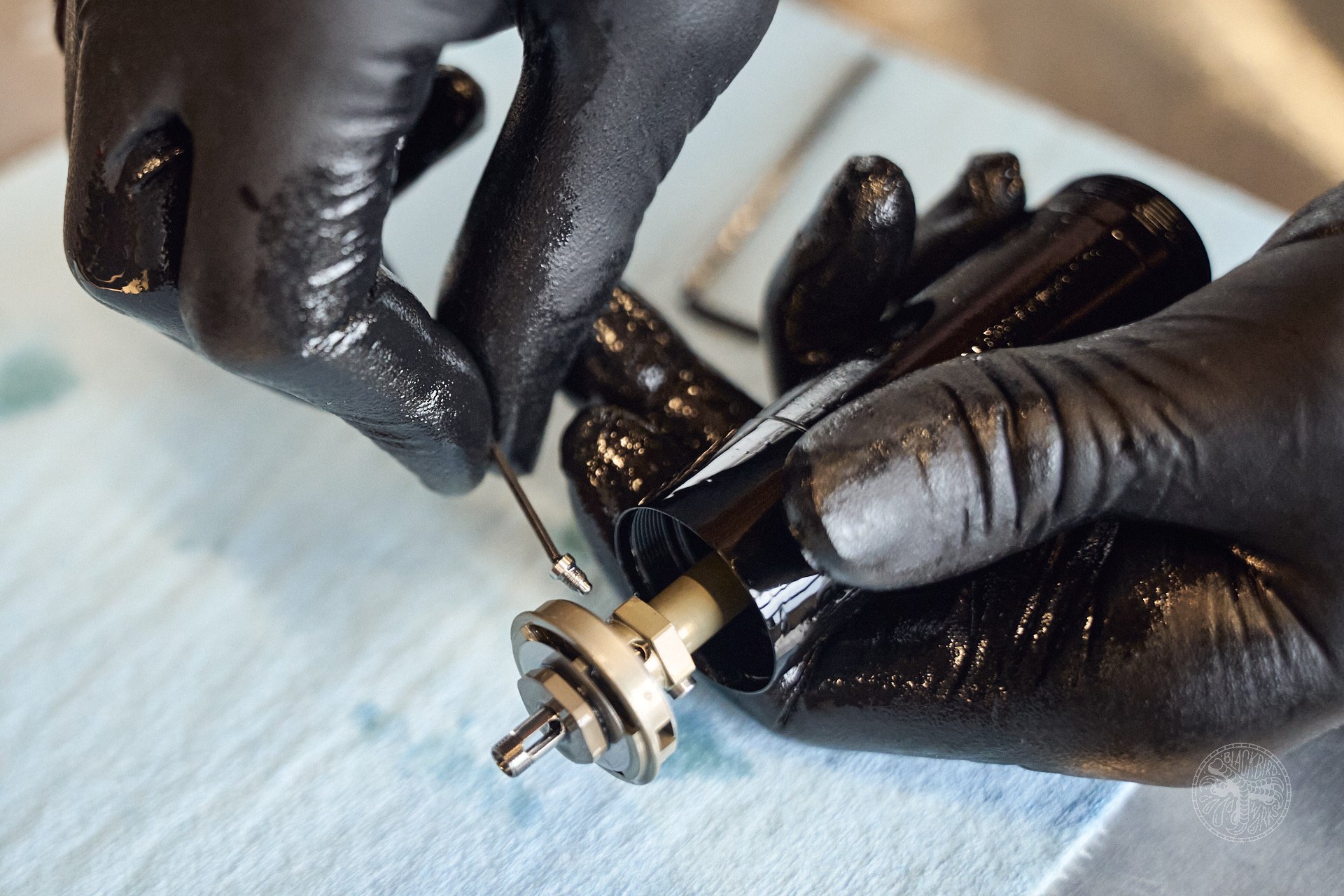
Franken Bolts! These are set screws with tips that control the HSC and LSC. The fork's adjusters adjust the track to change oil flow.
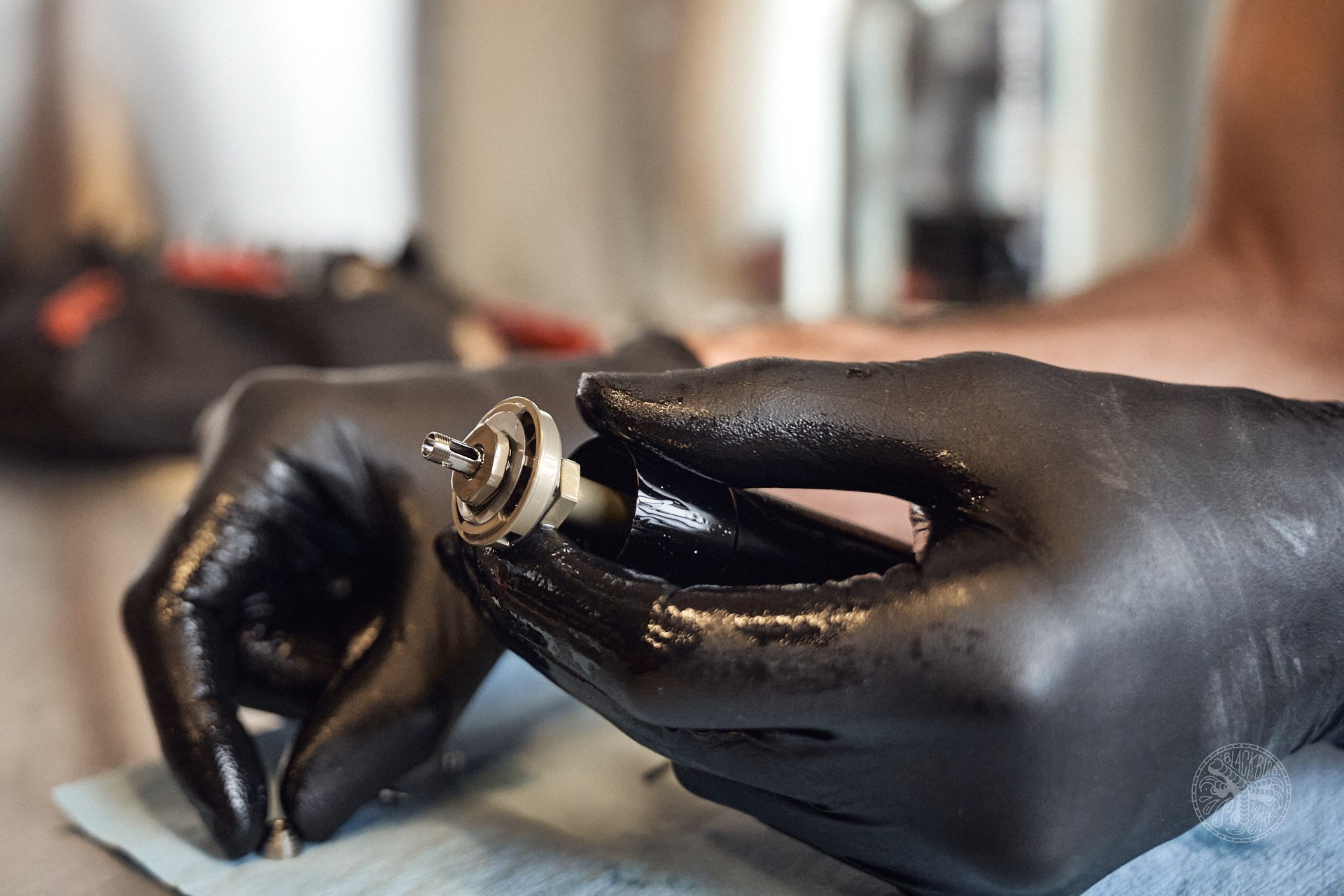
The LSC worm drive is in the center of the HSC circuit.
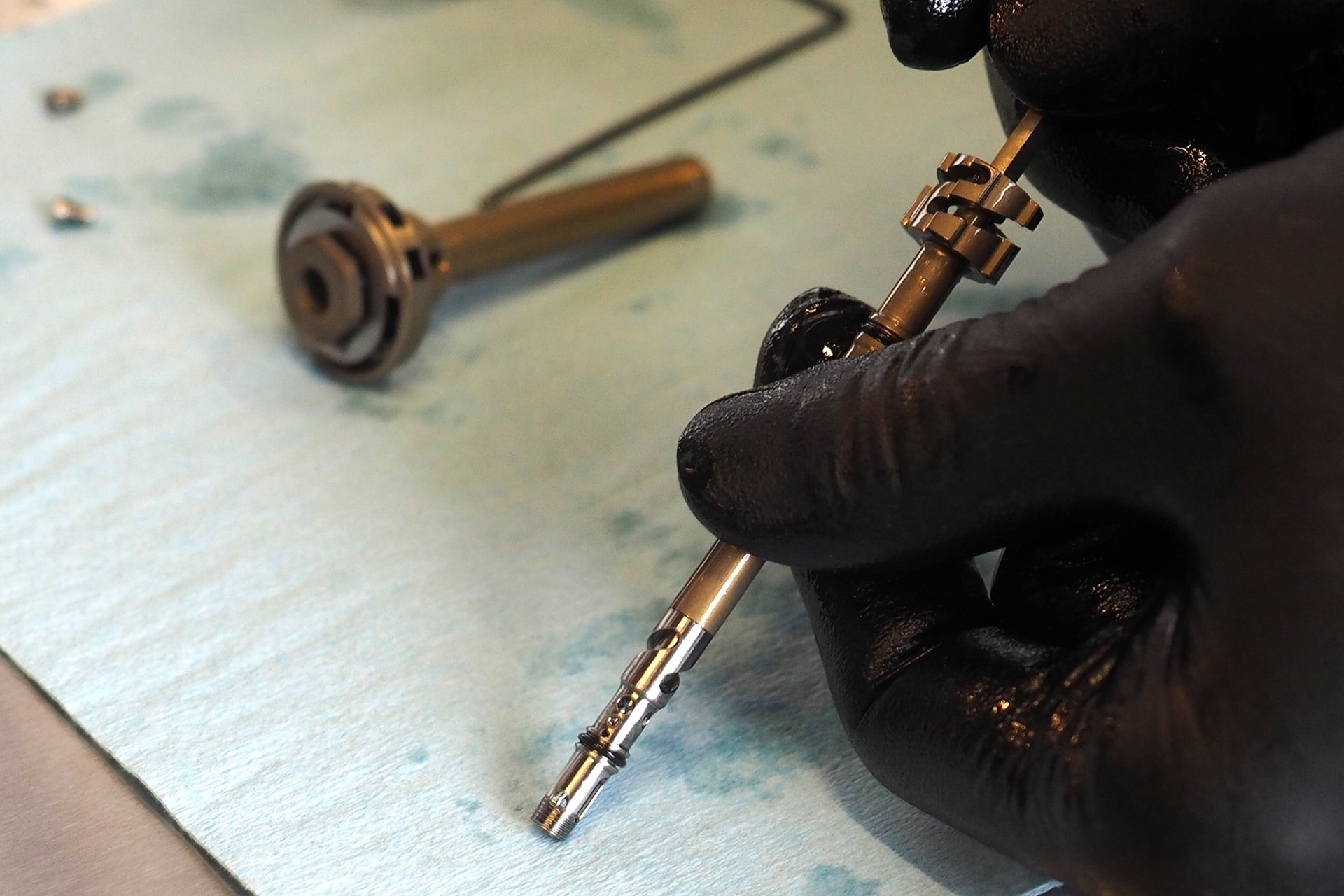
The worm drive is actually what's being adjusted, changing force, when you turn the LSC and HSC adjusters. Photo: Andrew Major
What's Up ButterCups?
What are ButterCups? Physically, they're 39 grams of rubber that deliver 4mm of vertical compliance. They take up space in the bottom of each leg, which is why they are not backwards compatible to previous model year chassis. As with other trail noise cancelling products - like Fasst Flexx bars and REV grips - their job is to absorb low amplitude, high-frequency vibrations. As with those other products the only real way to determine what difference they make for you is to ride trails back-to-back with and without the products. SRAM claims "small bumps and high-frequency vibrations were reduced by 20% with the use of ButterCups, confirmed by sensors in ride testing."
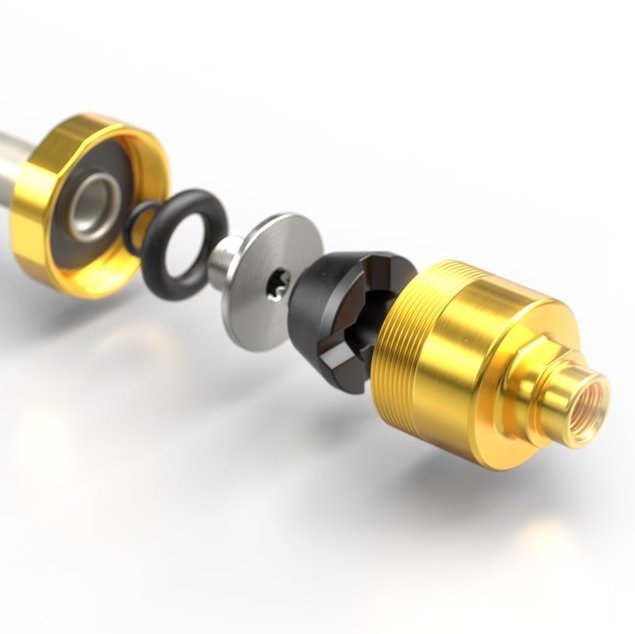
Here's a rendering of the ButterCup assembly. We were pressed for time so we didn't take one apart. SRAM recommends replacing the rubber components during a routine yearly service. Image: SRAM
If you're buying a bike with a MY23 RockShox fork and it has ButterCups installed, there will be a gold 'ButterCups' sticker on the lowers. If you're buying a Base, Select, or Select+ fork and want to add the bumpers, RockShox says that's possible "by purchasing a new DebonAir+ air spring and Charger 3 damper equipped with ButterCups." SRAM recommends routine replacement of the ButterCups during what they call a '200hr' service. This is their yearly full teardown service and is intended to complement a basic lowers service every 50hrs of riding.
Personally, I think (every) manufacturer's push to assign a higher number of hours to their yearly service is asinine marketing bullshit. If you're like most folks, and ride your fork <100hrs a year, then store it properly and get it serviced yearly. Easy. If you're lucky enough to ride your bike significantly more than 100hrs a year and perceptive to the performance to an extent that products like the Charger 3 damper, DebonAir+ air system, and ButterCups matter to you, then I know you'll back me up in saying that said fork is going to feel like crap long before you hit 200hrs and no matter how much Slickoleum you slather on, a routine lowers service isn't going to cut it. Treat that yearly service interval as an absolute maximum and your bike will work much better for it.
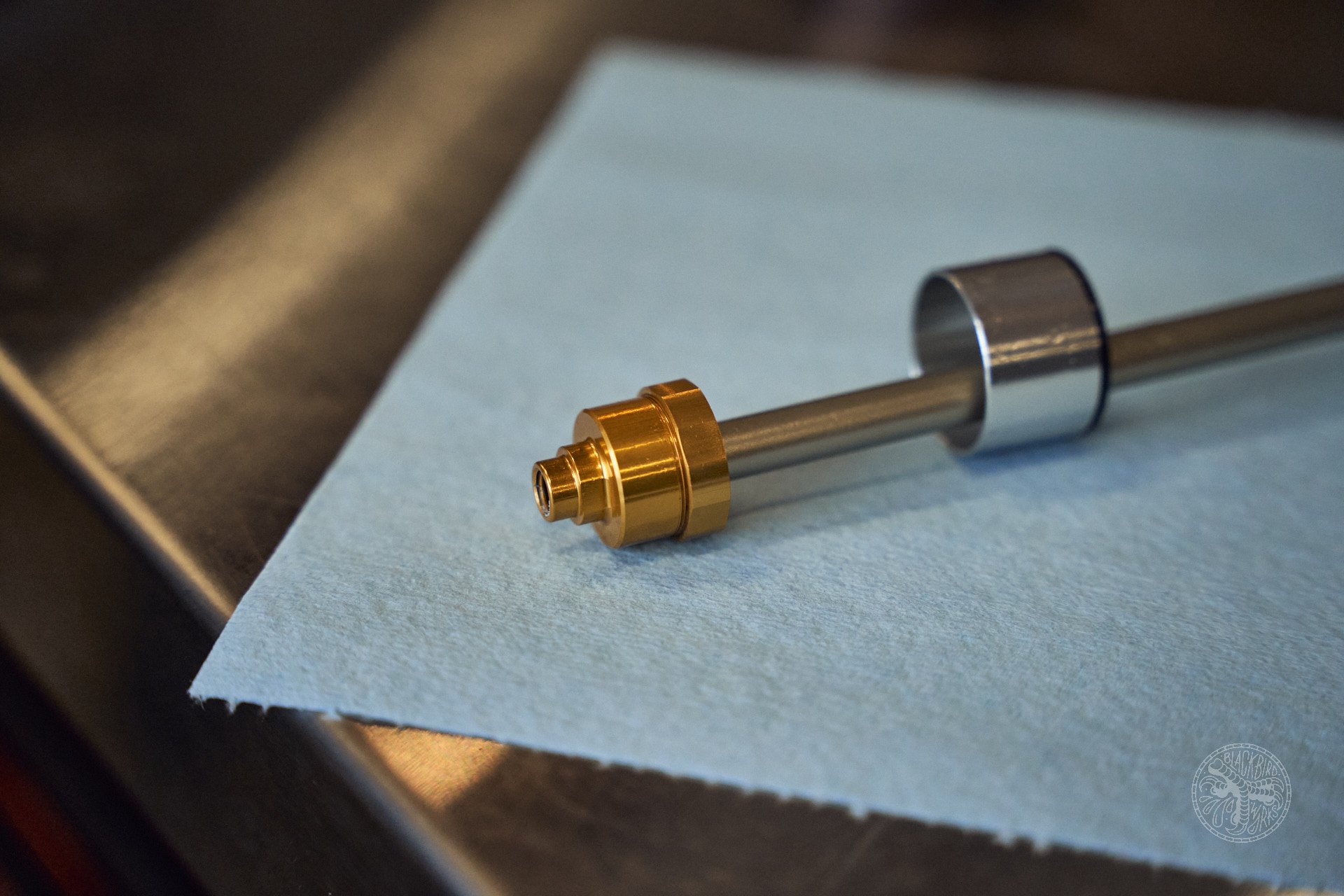
There's a ButterCup on each side of the fork. If you're feeling nerdy the air side 'Cup weighs a claimed 18.6 grams.
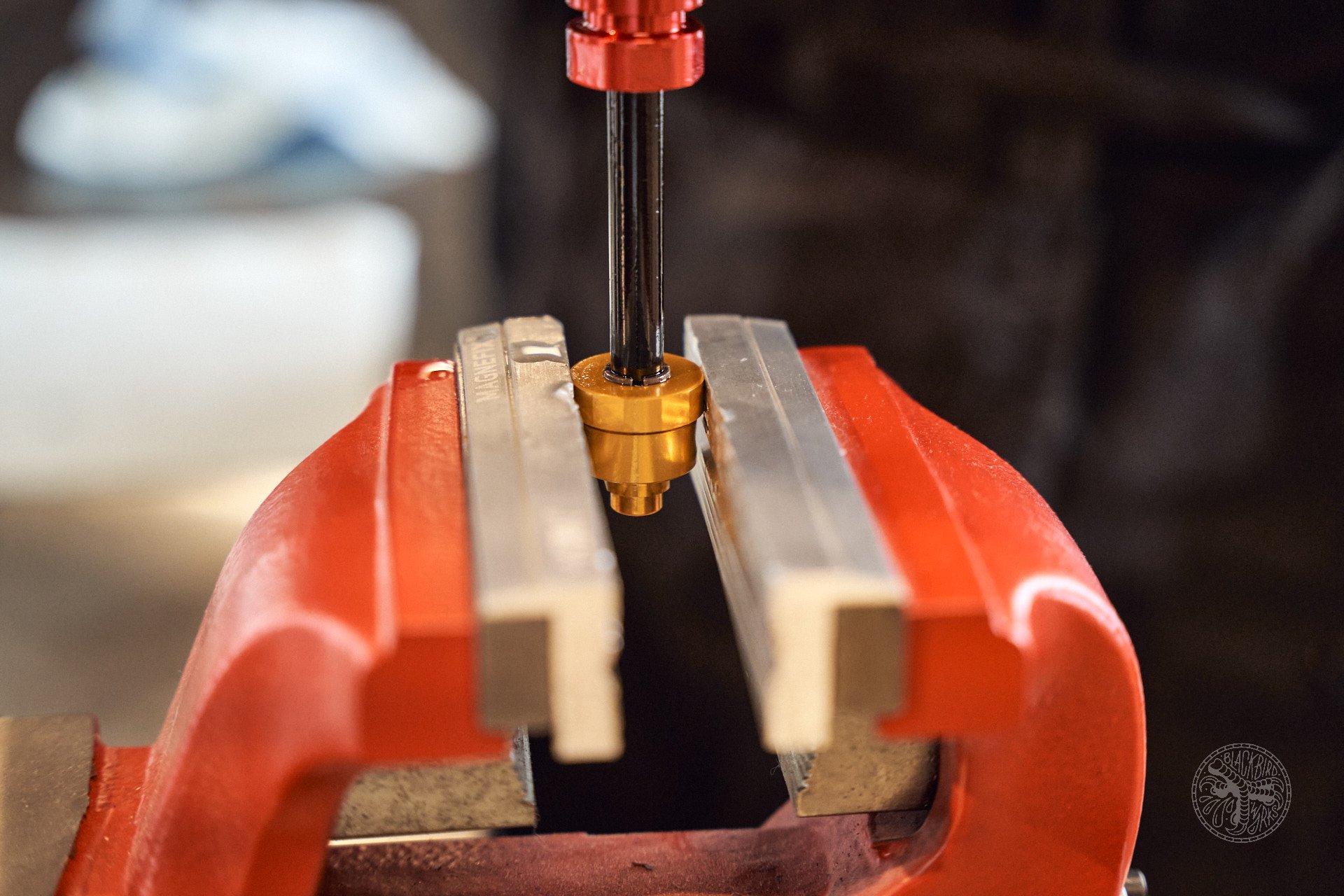
And the damper side weighs a claimed 20.4 grams. Yep, 39 extra grams.
PRV Philosophy
I'm a pressure relief valve (PRV) skeptic and my chief curiosity was whether RockShox actually believes they're necessary or if this addition is about keeping up with the Foxes. Changes in altitude and temperature can allow excess pressure to build up and affect fork performance. The ramp that occurs from this excess pressure only affects the end stroke, the way adding a volume spacer does. I don’t think it’s a big deal personally. Further, ports add complexity and magnesium is highly susceptible to porosity in manufacturing, which may lead to an increase in rejected castings.
Whether you love the addition of PRV or not, we can all appreciate that this adds a cost to the forks. Not just the top end Ultimate and Select+ products that come with them installed but also the Select and Base forks where you can purchase, and install, the PRV valves as an aftermarket upgrade.
The RockShox perspective is that the addition of 'burpers' is inline with all the work they've done to ensure completely independent, consistent, and notable, damper adjustments. Previously all RockShox fork air pressure suggestions were calculated with an allowance for 'casting ramp' included. And, as with the new damper, the suspension team at SRAM feel that the general riding population has become more sophisticated when it comes to ride feel and adding the bleed buttons is a meaningful addition to the forks.
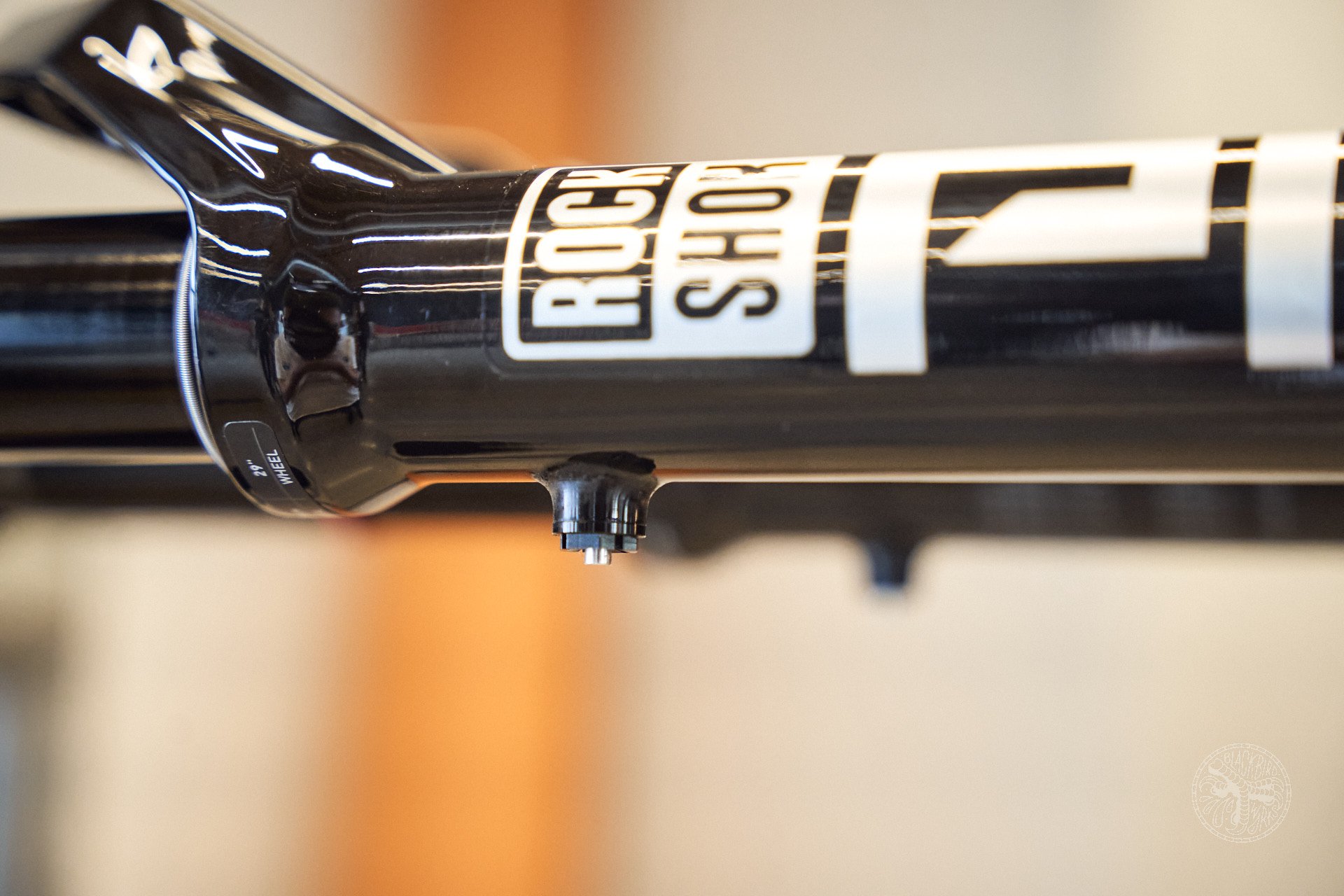
Push the buttons to relieve air pressure from the lowers for more consistent performance. With the less expensive forks you have to manually remove a hex screw.
SRAM goes a small distance in contradicting their view of this new level of sophisticated mountain bicycle rider in their marketing material. I enjoyed this almost on the level of Wolf Tooth boldly informing potential customers that you can't use center lock lockrings with 6-bolt hubs. Anyway, I figure I'll help SRAM get this important message out about not riding your fork with two gaping black holes in the back of the lowers:
"The Pressure Relief Valves (PRVs) or plugs can be removed while the fork is stationary, but they must be installed before riding. Leaving the PRVs or plugs out while riding can result in lower leg lube loss and dirt ingestion."
While I'm on the subject of the lowers, each side now requires 20cc of bath oil in the lower legs. This bath oil is different from the 7w oil in the damper but SRAM has done extensive dyno testing to confirm that it's not a big deal as fluids mix over time from the Charger 3 damper ingesting bath oil and then purging fluid back into the lowers.
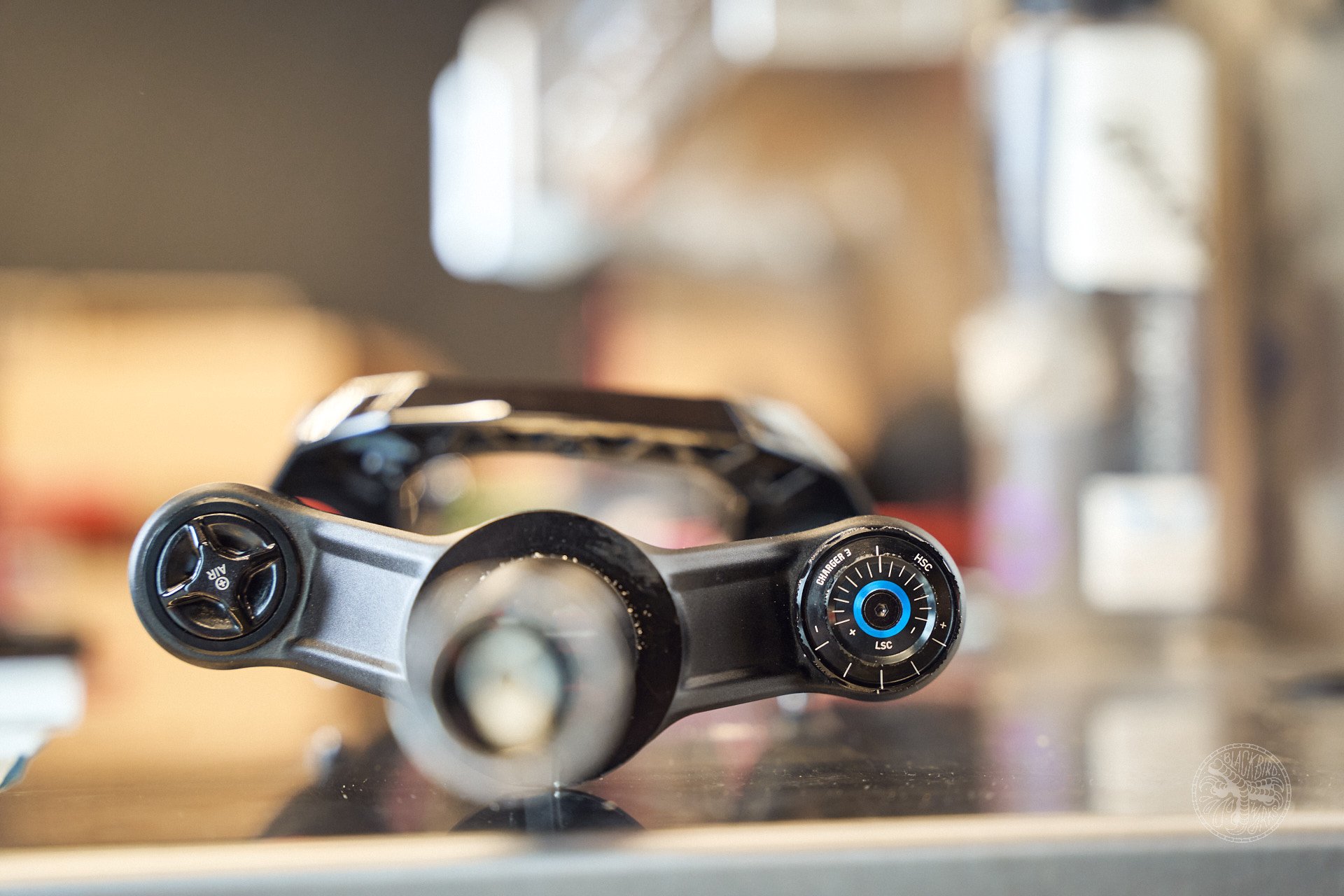
RockShox did a nice job with the new adjusters. They feel fantastic and look good too.
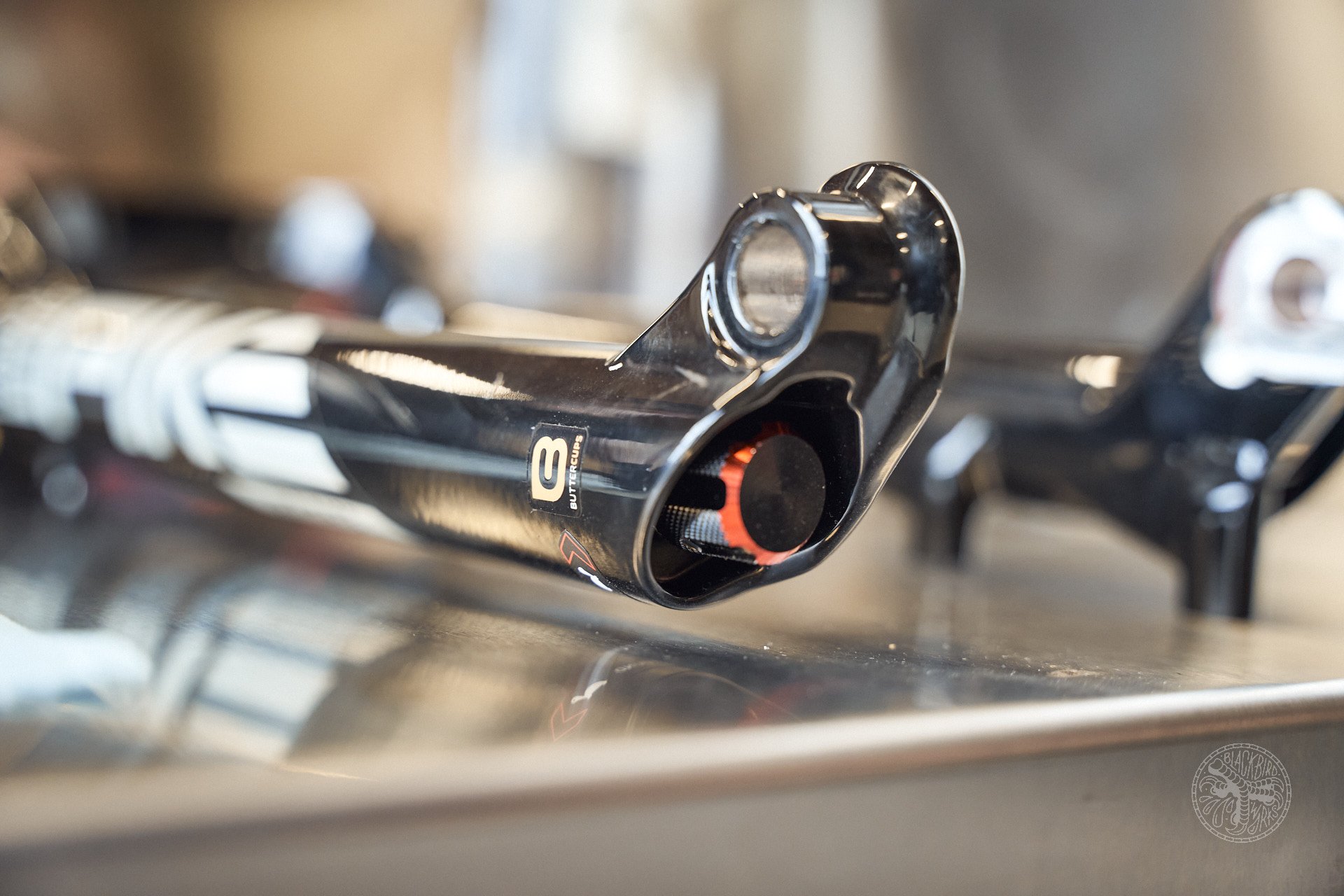
I'm particularly fond of the black rebound knob with just a touch of classic anodized rebound-red.
DebonAir+ & Chassis Tweaks
The new DebonAir+ air system is shared across the Pike, Lyrik, and ZEB lineup but with the increase in specificity between these forks, RockShox has taken the smart step of colour coding everything for easy identification. For example, if you're converting your 130mm Pike to 140mm travel and converting your 150mm Lyrik to 140mm travel both those forks will use unique air systems but they're easily identified by colour accents. Where the Pike, as you can see in these photos, has some anodized silver components*, a Lyrik air system will have anodized red components.
*Other than the gold ButterCups
The dimples in the stanchions that allow air pressure to be transferred between the positive and negative chambers have been relocated to better optimize the positive and negative air pressure within the more limited travel ranges of these new products. Along with tweaks to the individual chassis, the air spring volumes have been tailored to the ideal use cases of each platform. I don't know to what degree a Zeb will ride differently from a Lyrik, and how differently a Lyrik will compared to a Pike but it makes sense that riders are going to want different ride qualities and performance outcomes from different fork platforms.
Between the noted increase and optimization in bushing depth and the redesigned chassis themselves, RockShox is claiming "the new Lyrik has 20% more torsional stiffness than the previous model, and the new Pike has 13.5% more torsional stiffness than the previous model." What's interesting about these numbers is that means compared to the Zeb a new MY23 Lyrik is only 1.5% less stiff torsionally. Put another way, RockShox claims the Zeb is 21.5% stiffer torsionally than the previous Lyrik chassis and the new MY23 Lyrik is 20% stiffer torsionally than the same fork. With the focus on torsional stiffness, I think this is a solid reason for anyone weighing performance v. weight to purchase a 35mm stanchion 160mm travel Lyrik over a 38mm stanchion 160mm travel Zeb.
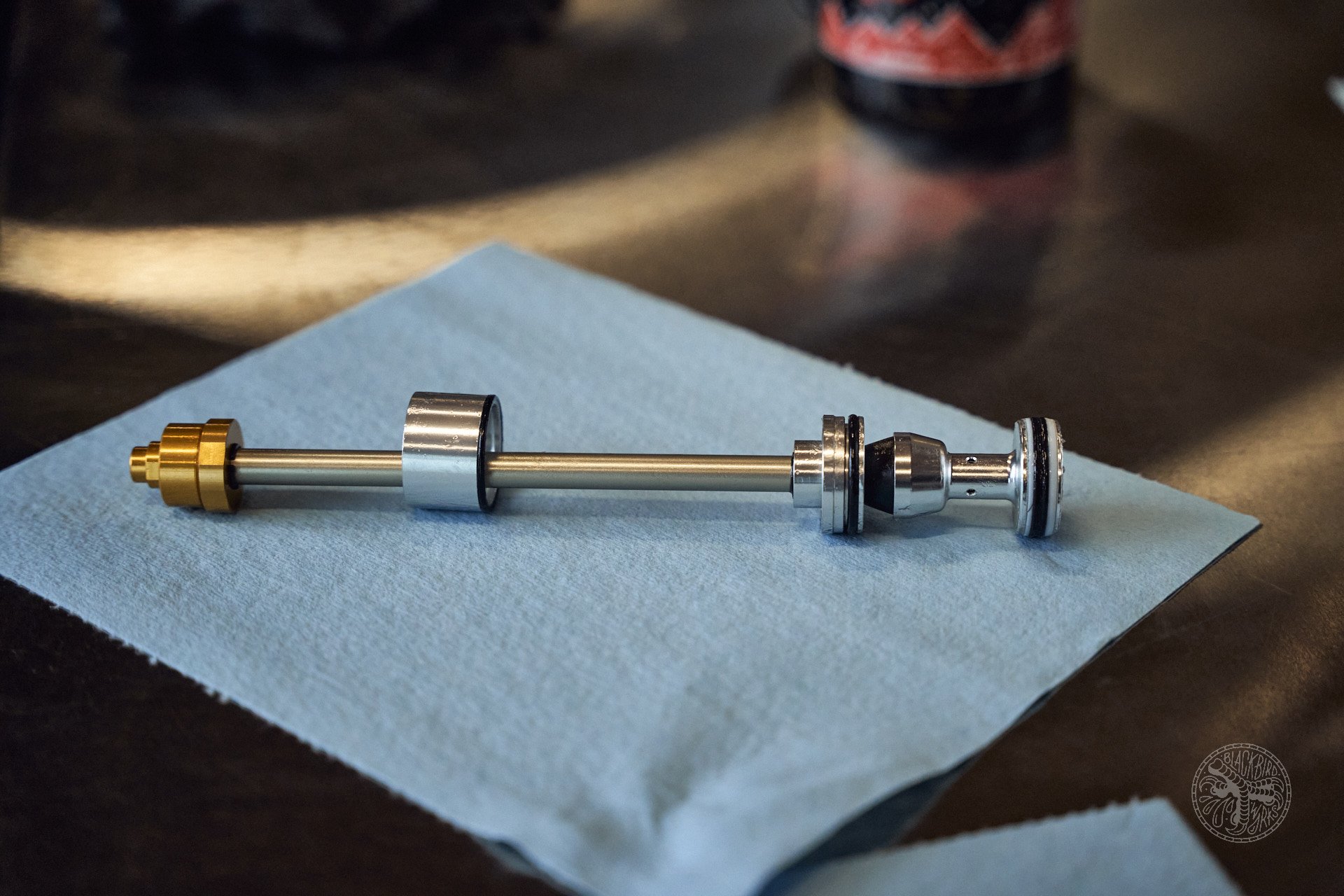
Colour coded for simple identification. The Pike air springs have anodized silver accents. If this was a Lyrik there'd be ano-red components.
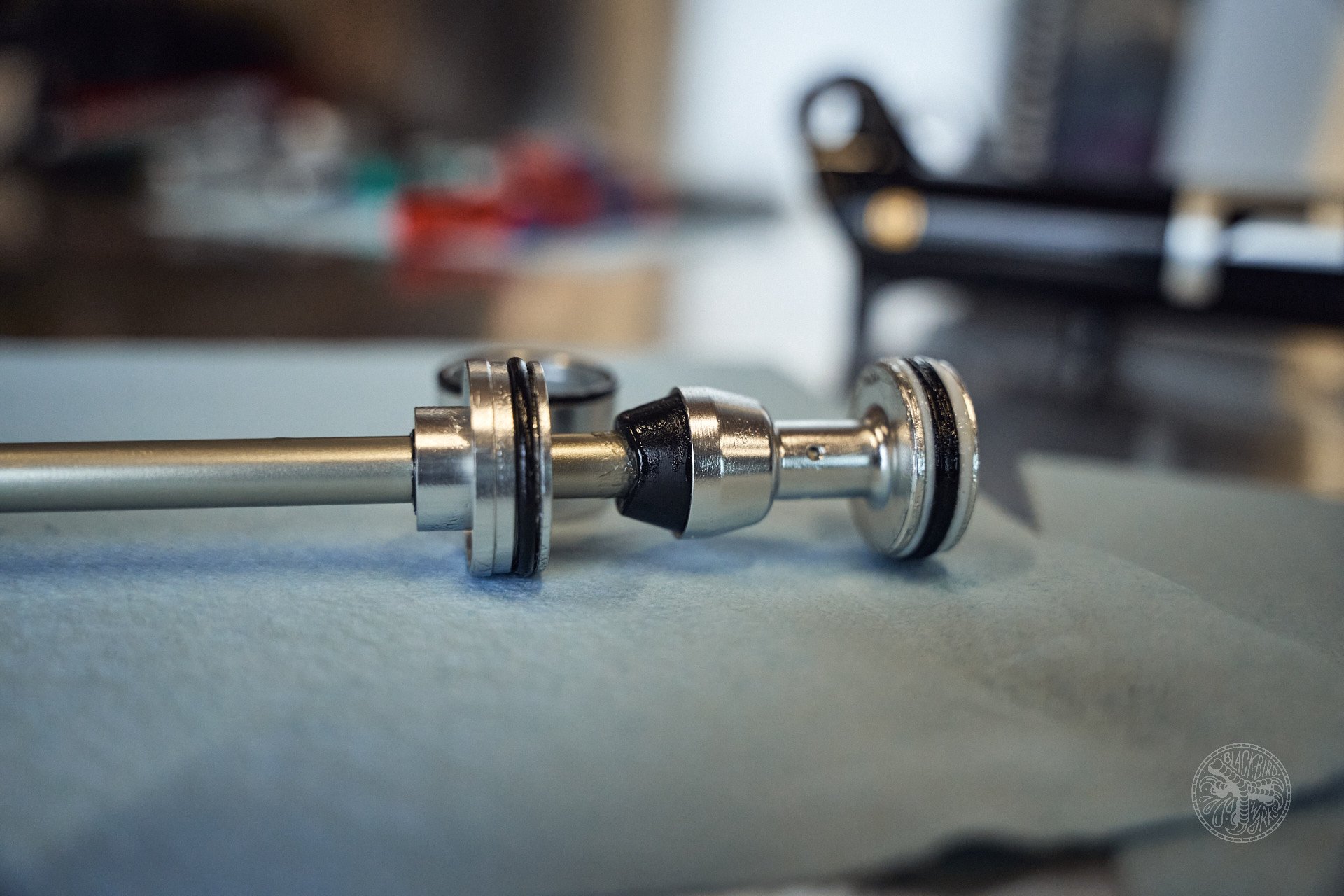
Smooth is quiet. Quiet is smooth. There's a healthy top out bumper keeping things feeling, and sounding, premium.
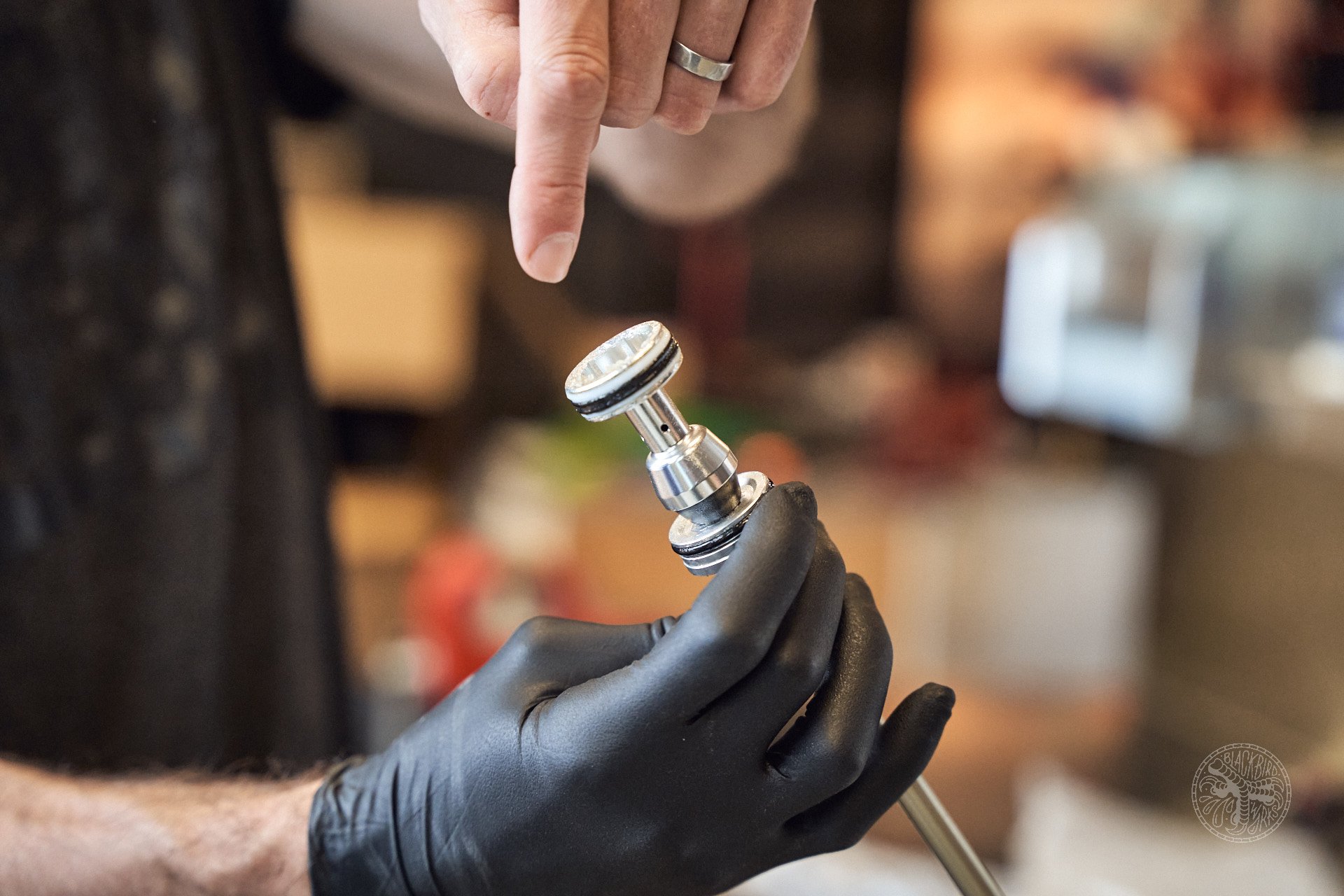
The dimple locations in the air-side fork stanchions have been changed to optimize the positive and negative chambers around the more limited chassis-specific travel options.
How the new DebonAir+ system and travel optimization compares to previous RockShox air systems on the trail is going to come down to fork reviews. I imagine the first impression of any of these forks - Zeb, Lyrik, or Pike - is going to note how quiet they are as they go about the business of creating traction and absorbing chatter. The new damper, the ButterCups, and even the impressively larger top-out bumper in the air system, have all been engineered around the idea that silence is luxury. Sort of like testing different trim levels of the same automobile and for whatever reason the more expensive models are always quieter on the road. Having experienced plenty of fork setups that 'breathe' quite a bit I can attest to the fact that the majority of riders would prefer the silent treatment.
One other thing to note with the new air system is that changing travel no longer just involves swapping out shafts. Rather, the fork owner will now be swapping whole air spring assemblies. The net user experience, assuming the difference in optimizing air pressures is as notable as claimed, will be better for it but for the tinkerers out there this adds expense compared to experimenting with travel on the previous generation forks. While I'm certain this is a tiny minority of riders, forks like Cane Creek's Helm or Manitou's Mezzer use travel spacers rather than air system swaps so if you're the rare seeker keen on experimenting, one of those systems is probably the better buy than the more common usage of a dimple to balance positive and negative pressures, which also requires the air piston to remain in a constant position relative to the dimple as travel is adjusted.
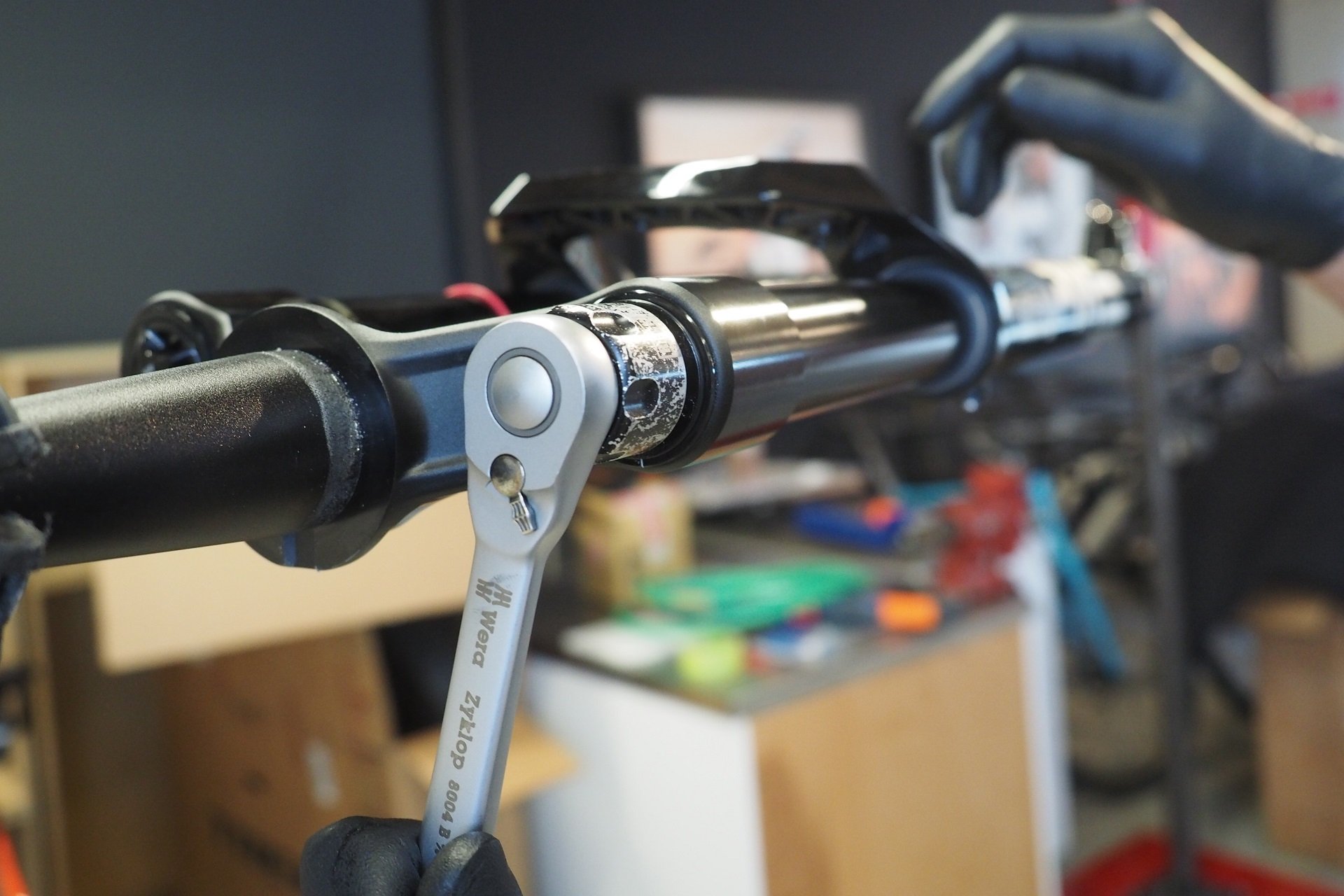
When my daughter was a tiny grom she tried to run away with a titanium Abbey Tools hammer that my friend Dave McInnes was showing her. Photo: Andrew Major
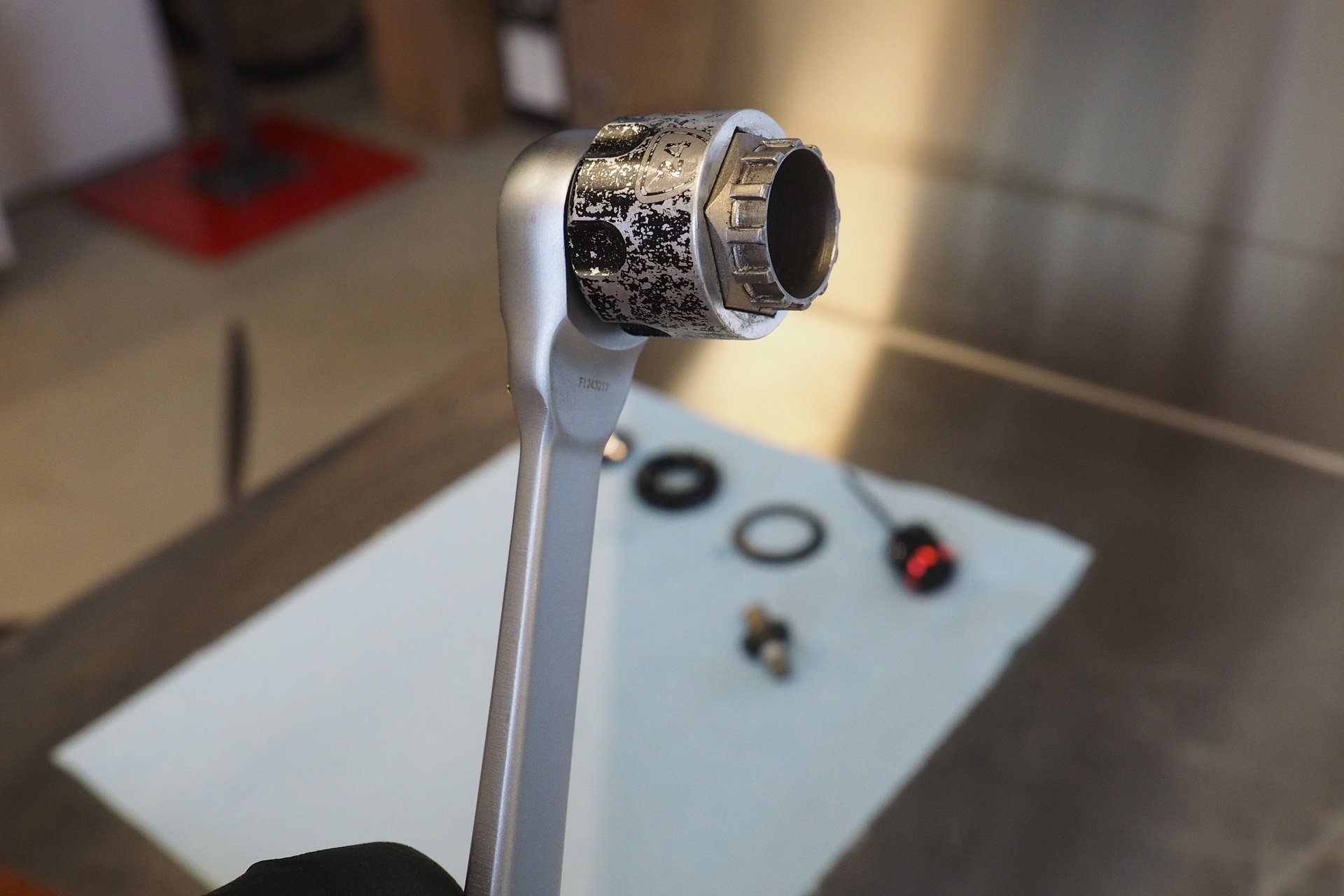
Dave and I laughed, and laughed. And then I chased her down and made her give it back and she was not impressed at all. Kids, am I right? Photo: AM
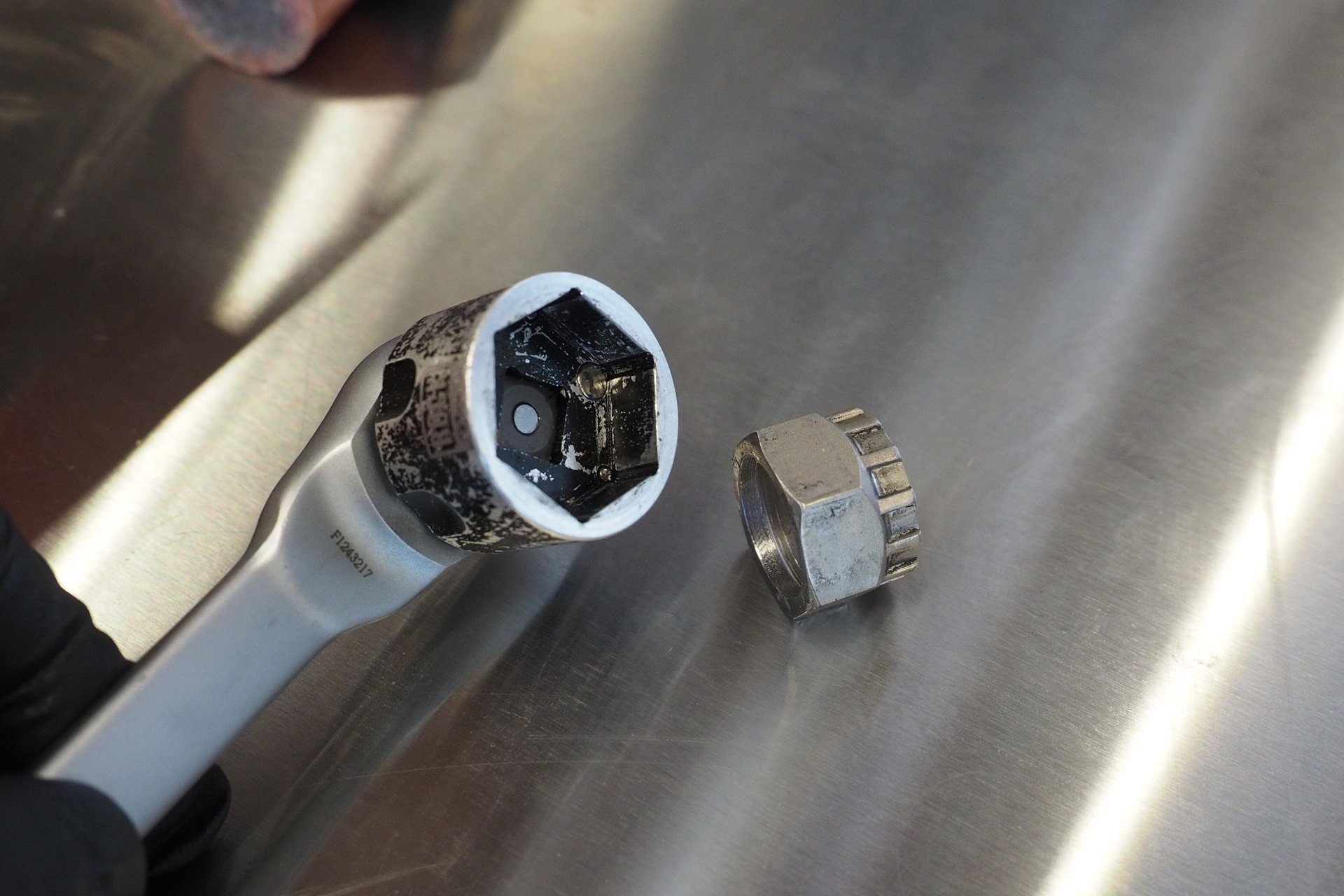
What I'm saying is, Chris still owns this tool because I'm positive - Achilles injury or otherwise - that he can run faster than I can. I probably mostly want it because I can't have one. Photo: AM
I imagine most folks will find the new Charger 3 damper the most interesting feature of the new forks. The quality inside is premium and I've talked to a number of riders over the years who were concerned about the independence of adjustments. For me, the ultimate feature of the Ultimate forks has to be the ButterCups and I find myself wishing they came at every level of RockShox suspension. From the Easton MG60 stem, to Specialized Zertz inserts, to Fasst Flexx bars, and Rev Grips, using a few millimeters of rubber bumper compression to smooth vibration is not a new idea but I think the ButterCups are a nifty and neatly delivered take on the concept.
If you have any questions please fire them in the comments below and I'll do my best to answer them or track down an answer for you.
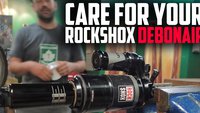
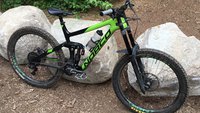

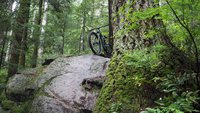







Comments
cxfahrer
1 year, 10 months ago
Gold Rush!
The way to go :D
Thanks for explaining. I really noticed a better performance of my slightly sticky Lyrik when slackening the angle from 65 to 63.5. I have to ride down stairs here for anything that resembles "steep".. 😂
Reply
Andy Eunson
1 year, 10 months ago
No propriety tools. That’s important to us home mechanics. One reason I stopped overhauling dampers at home is that many forks require those tools. A one time purchase is acceptable but when the tool changes from model to model it pisses me off.
I have had forks that needed an air relief because of I think negative pressure in the open bath. Hard hits see an increase in psi in that chamber and hard hits cause maybe some flex and air escapes through the wiper. The results are a fork that is partly sucked down by over a cm on a 150 and 160 Fox 36. A careful insertion of a very small plastic zip tie cures that. It’s not hard to do but care is needed to not damage a stanchion or wiper. A PRV is just easier. Do motorcycles have this issue?
Reply
Andrew Major
1 year, 10 months ago
No proprietary tools and I think it’s more foolproof to bleed than a bladder damper as well.
Chassis ramp shouldn’t be sucking a fork down. That sounds like an issue with the transfer port. Seen lots of that, usually caused by grease interfering with the transfer of air.
But yeah, for folks letting air out of their stanchions regularly with a zip-tie, PRV is a win, certainly.
Reply
Andy Eunson
1 year, 10 months ago
Except that over greased pistons are inside the air chamber and won’t be relieved by a zip tie in the seal.
Reply
Andrew Major
1 year, 10 months ago
Yeah, had to phone a friend on that one as it didn't make any sense to me that it could be caused chassis ramp.
Anyway, by far the most likely cause is the air system leaking air into the lowers. I guess using PRVs (or burping the seal with a zip-tie) is a temporary solution, but rebuilding the air system with new seals would be the best practice fix.
Reply
Justin White
1 year, 10 months ago
Did it become stuck down after the big hits, or did it start stuck down after maintenance and just go unnoticed until the big hits? I've seen a few forks with "negative pressure" in the lowers after getting the bottom nuts/bolts tightened without the legs beings fully extended. It's probably why Fox now explicitly tells you to inflate the air spring before putting the legs back on.
Reply
Andrew Major
1 year, 10 months ago
The issue with forks sitting down in their travel has been around since before self-balancing air springs, but I’ve only seen it with forks coming off the bench never something that happens mid-ride.
Unless if the rider simply didn’t notice before then the most likely culprit of the fork sucking down on a ride is a blocked transfer port, but if the issue can be fixed with burping a seal then it’s probably the air system leaking into the lowers.
Reply
Justin White
1 year, 10 months ago
Leaking into the lowers? If the lowers got more pressure, that would make it ramp, not stick down...
However, very agree if it happened mid-ride then blocked port is likely culprit. Depending on how far down it is, some added positive pressure and manual extension of the fork may help the piston reach the port and blow the blockage out and pressurizing the negative chamber again. I'm only 2 for 4 on doing this kind of external manipulation, and all on shocks (but the concept is the same), so YMMV.
Reply
Andrew Major
1 year, 10 months ago
That’s my understanding of chassis ramp as well, but Andy’s talking about air in the lowers causing his fork to stick down and it coming back up when pressure in the lowers is relieved. That only makes sense if it’s creating negative pressure.
It makes sense it could be that relieving pressure in the lowers is allowing the fork to be manipulated such that the transfer port balances again. I was thinking air leaking from the positive chamber into the lowers combined with the transfer port not allowing for calibration would effectively mean that the negative chamber was over pressurized.
Anyway, just trying to reason through what would cause it when the (temporary) cure is bleeding air from the lowers.
Reply
Justin White
1 year, 10 months ago
I don't see how air could get from the positive to the lowers, without going through the negative chamber...
Either way I think the mix up might be on the phrase "bleeding air _from_ the lowers". What I'm talking about would require bleeding air _into_ the lowers, relieving the negative pressure.
Andy Eunson
1 year, 10 months ago
I only noticed it because I was wiping down the stanchions and they didn’t look right. I measured the distance from crown to seal and it was less than the travel was supposed to me. I pushed the arch and pulled the crown and the fork would go further but settled down too low. When I slipped a zip tie under the seal I could hear a bit of air I guess going in. Cured the problem. I don’t let the air out when I service the lowers. And they were fine when I had serviced them. It was just a few times.
Reply
YDiv
1 year, 10 months ago
Super interesting note about damper and bath oil mixing - which only confirms what Dougal at Shockcraft has already mentioned. The amount of oil that's ingested (and consequently mixed) isn't enough to warrant using damper oil in the lowers as well.
Reply
Andrew Major
1 year, 10 months ago
Thanks for highlighting this. Yes, no need to be running damper fluid in the bath. That said, I wouldn’t run a product like Fox 20W Gold on the damper side of a semi-open bath fork. There’s effectively no difference if RockShox lower lube gets in the damper, but I’ve seen some heavy stuff in fork lowers.
Reply
Velocipedestrian
1 year, 10 months ago
Nice to see the purge/recirculation hole at the top of the damper. I first came across this idea in my Zocchi 55cr, and Fox seems to be keeping it too.
Reply
Andrew Major
1 year, 10 months ago
Otherwise the seal head quad has to be very tight to keep oil out - more friction - and even then shops see plenty of damaged bladders from I gesturing of bath oil over time.
I believe that Fox started doing with the purge port with cheap OE Evo dampers when they recalled/replaced them all in 2013. It’s simple and it works.
Reply
cxfahrer
1 year, 10 months ago
This Ultimate bushing treatment makes me wonder. Was it really a common problem with RS forks until now that the bushings did bind a bit when smashing hard?
Or is this an extra quality control treatment for extra money, and the reason for my sticky old 2018 Lyrik was just bad quality control, like before with my 2009 Lyrik A1?
So when I buy non-Ultimate forks I have to expect sticky or sloppy forks? Plus a RUSH damper, whatever that is?
I guess a lot of the lower end bikes (that would be around 3500) will get those Select and Rush versions.
Reply
Andrew Major
1 year, 10 months ago
Not a RockShox specific comment, but I think there was certainly lag between when trail bikes started getting much slacker HTAs and suspension manufacturers started designing systems (bushings/stanchions) to resist binding during telescoping. Especially in less-steep rugged terrain where forces are trying to move the wheel in every direction except inline with the plane where the fork lowers need to go.
Hence so many aggressive riders gravitating to the heavier uppers of ‘e-bike rated’ forks.
Further, most bushing systems are hydrodynamic (there needs to be a layer of oil between the bushing and stanchion) so in the above situation if the fork isn’t routinely serviced and stored properly there will be a significant increase in binding and bushing wear.
———
More bushing/stanchion contact, made possible in part by reduced travel ranges, is great in theory. But it’s only going to be a net benefit on forks that are properly maintained/stored. Otherwise I’d expect more binding and friction.
———
To answer your question, I know plenty of riders charging hard on the last gen Lyrik who’ve never complained about issues with binding. So I think it probably comes down more to QC/QA on individual forks and, of course, service intervals.
I have seen a couple RockShox forks (both Boxxers) over the years that escaped QC with wickedly bad bushing bind from issues with the lowers but in both cases SRAM replaced the lowers tout de suite.
Reply
Andrew Major
1 year, 10 months ago
I’ll admit, as cool as it’s going to be listening to folks who’d never consider, or have even openly ridiculed, a noise-cancelling elastomer-sprung product like Fasst Flexx bars or Rev grips as they wax enthusiastic about the difference 4mm of ButterCup travel makes, the real story in MY23 as far as the number of riders affected is at the lower end.
Especially, and I feel I alluded to this, when it’s deep into the game of counting nickels and every Pike/Lyrik/Zeb is shipping with PRV compatible lowers.
I’ll keep my eyes open for an opportunity to review a Rush equipped bike.
———
I just realized that if they do a version of the 35 Gold with the Rush damper it will be a Gold Rush. And I laughed…
Reply
Sethsg
1 year, 10 months ago
Kinda sad that the lyric is not available in 170mm travel.
Reply
Andrew Major
1 year, 10 months ago
You’re not the only one, especially with the claims that the new 35mm Lyrik Ultimate is within 1.5% of the torsional rigidity of a 38mm Zeb. I know torsional rigidity isn’t the only metric that matters but it’s still a nice opportunity to min-max weight v. stiffness.
Reply
Kenny
1 year, 10 months ago
Too bad the updates aren't backwards compatible, but I get that at some point they have to make a step change and that upgrade chain breaks, I guess.
I find my '21 lyrik ultimate to be pretty mediocre, and the recommendations are always either to go backwards in time to a B1 airspring, dump a ton of money into it (HC97, etc) . Kinda hoped this might have presented some new upgrade paths I guess.
Reply
Andrew Major
1 year, 10 months ago
I was really surprised that, making room for ButterCups aside, there is no backwards compatibility with the new air system and damper.
If you don’t mind me asking, what issues are you experiencing with your ‘21? Changing the air system and installing a Push damper are both accomplishing very different things is what drives me curiosity. You’re already running your air system sans tokens?
Reply
Kenny
1 year, 10 months ago
The air spring curve is just shaped like a hammock. Very stiff at the initial travel, boggy through the middle, then ramps up again.
If I lower the air pressure enough to fix the initial harshness it becomes terrifying when riding anything steep. If I pump it up it feels great on steeps (as long as things don't get too fast) but miserable at higher speeds.
The two changes address this in different ways I suppose - The B1 addresses it directly - it doesn't have the aggressive topout and has a more functional negative spring, so you can run more pressure and have more midstroke without the small bump dying.
The idea with the HC97 is to improve midstroke at lower pressures via more damping. I think that may be the biggest weakness, stock damper provides minimal low speed compression damping as the HSC circuit just bypasses. If you close HSC up enough for the LSC knob to do anything, the fork just starts to feel... wierd.
My other two bikes have a Fox 38 RC2 and a DVO diamond d1 and both are much easier to dial in. I mainly attribute this to the fact that the damping adjustments actually make a difference.
Reply
Andrew Major
1 year, 10 months ago
I asked a couple friends with Lyrik Ultimates and, I don’t know if this is helpful, but the recipe for success with a stock fork is apparently to 1) make sure the fork is running super smooth, 2) run no volume spacers and <20% sag, 3) run more HSC.
The least expensive tune is to get your damper revalved when you’re sending the fork in for a yearly service. Your local tuning center (for me it’s Fluid-Function). While it’s there I’d ask them to check the bushing sizing.
For mods it sounds like going to a coil spring conversion (Push or Vorsprung) is a win, but it always comes back to how much you’re willing to invest into your current chassis.
Reply
Kenny
1 year, 10 months ago
Yeah, I should ask fluid function. I've always been told they're not in the business of charger revalves but admittedly I've never asked them directly.
If so, that and a B1 sounds the best option. Everything else is such an expensive rabbit hole it doesn't make sense (also I've heard the forks suffer from being underdamped even more once coil converted, since it eliminates some friction from the airspring, so do a vorsprung coil and an HC97 and now you've almost doubled the price of an already not-cheap fork. I can't stomach it.) The irony is I really like the super deluxe ultimate air, so I'd like to make the lyrik work to keep things the same brand and serviced at the same shop
I'd been wanting to try a travel change on my new frame anyways so I bought a new 150mm B1 for 50 bucks shipped, then I'll have the parts, so I can also make my 160 and 170 air springs B1 flavored if needed. Should be interesting.
Reply
Justin White
1 year, 10 months ago
I would def go back to the B1 spring. I noticed the exact same thing when I upgraded my Pike to C spring. Sure it sat taller when the bike was unloaded, but that's literally useless on trail, and the resulting spring curve was absolute garbage, exactly as you described.
Although, I didn't end up reverting that Pike's spring; instead I went back to an entire fork I know and love, Factory 36 GRIP2, which has an actual enjoyable spring curve. For sensitivity, I mean, that thing moves when I'm pushing the bike up the stairs out of my basement, but still holds me up in the middle and my 100 kilos rarely bottoms it with just a token or two.
Reply
roil
1 year, 10 months ago
I have a '22 lyrik ultimate with a DSD runt. I haven't found the sweet spot with it yet but I feel like it's an improvement.
Reply
minotaur
1 year, 10 months ago
If the air spring is crap, leave alone the damper and fix the air spring.
The Luft Fusion kit does a pretty good job at that.
Reply
Justin White
1 year, 10 months ago
I can't wait to see more analysis of their claims of reduced damper "crosstalk".
I get the high flow pistons allowing more oil through the check valves, but that's not a case of rebound adjustments affecting compression damping directly. Even existing rebound check valves flow the same no matter the rebound setting. The high-flow just means more of the compression damping is coming from the adjustable compression valves and the rebound check valve is acting less like a pre-set mid-valve. This isn't necessarily good or bad, just a different way of tuning the base compression damping.
However, HSC and LSC will always have some interaction. Just because there is a free-bleed through the HSC circuit, that doesn't change the fact that the change-over point is dependent on both LCS and HCS settings. Is there a mid-speed valve that somehow overlaps both HS and LS and controls the change over?
Reply
Andrew Major
1 year, 10 months ago
To reiterate, I haven’t ridden the fork. I also think I make it clear that strictly from an on trail performance perspective, I don’t think the lack of cross-talk is hugely important.
Apparently, as per their dyno testing, the LSC and HSC are so close to independent as to be considered independent. I haven’t seen a graph.
The advantage for most riders is going to be psychological. I have ridden some forks though where, like CCDB shocks, it’s necessary to add HS to get the desired LS performance so certainly independent circuits will be more intuitive - I.E. “different” won’t matter to some riders but may really make a difference for others.
I’m looking forward to hopefully playing with the system in the future. Particularly riding the new air spring.
Reply
Please log in to leave a comment.